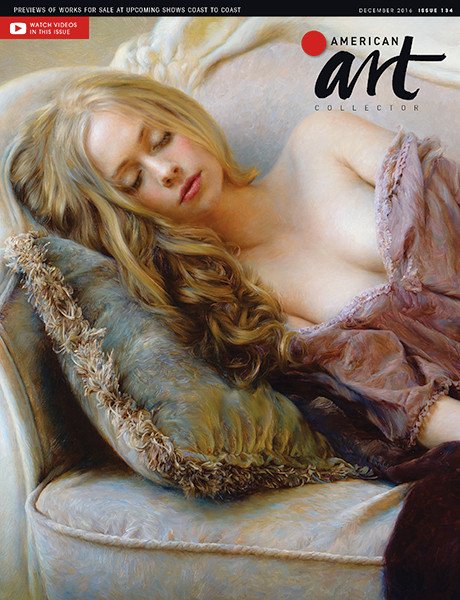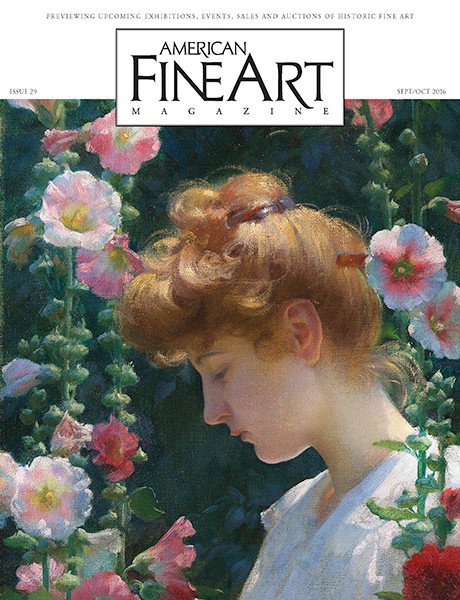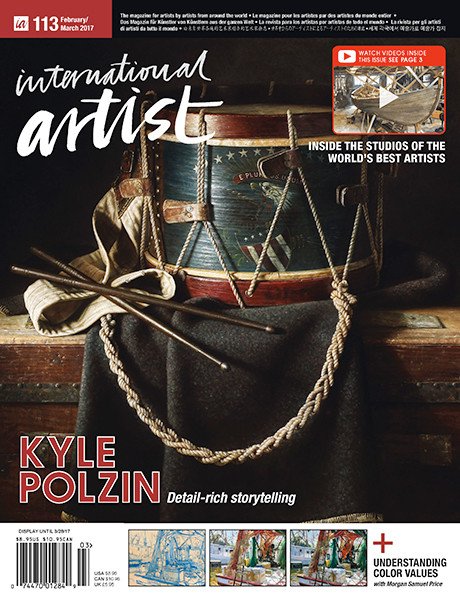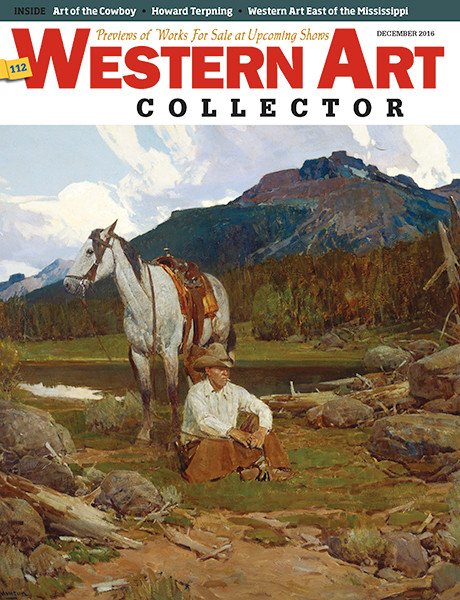Adobe Gallery
221 Canyon RoadSanta Fe, NM 87501
505-955-0550
Email this Gallery
Visit Gallery Website
Tradition and Innovation in Cochiti Figurative Pottery
12/4/2020 - 1/30/2021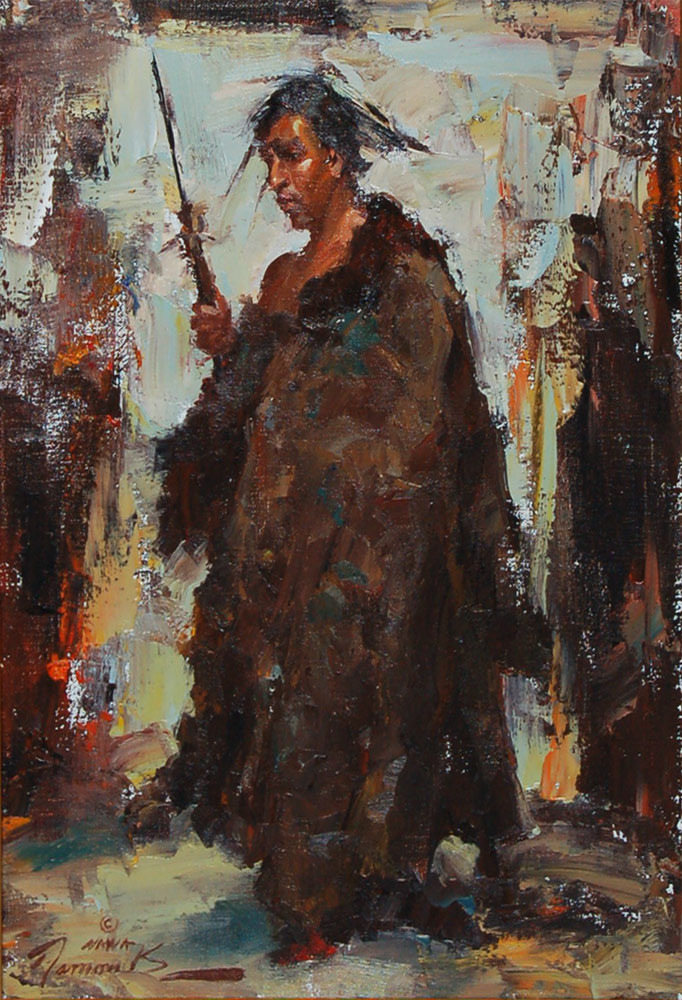
Item # 17437 Original Oil Painting titled “Buffalo Robe"
Ramon Kelley, Western Artist
Oil on Canvas
16 x 12 inches (L x W)
Ramon Kelley began his art career at an early age by drawing in the margins of his schoolbooks. He earned early recognition as a young artist and has continued to grow professionally. Kelley credits Russian artist Nicolai Fechin as a major influence on his strong figural paintings. Subject matter of primary interest to Kelley is Mexican and Southwestern scenes.
Although living in Denver, Colorado, Kelley goes on sketching trips around Taos, New Mexico. It is there that he paints some of his finest Southwestern landscapes and Indian subjects. He is regarded as especially successful with portraits of young people and older people.
This painting of an Indian wrapped in a buffalo robe is excellent testimony to his ability to portray strong portraits as gleaned from his inspiration of the art of Fechin.
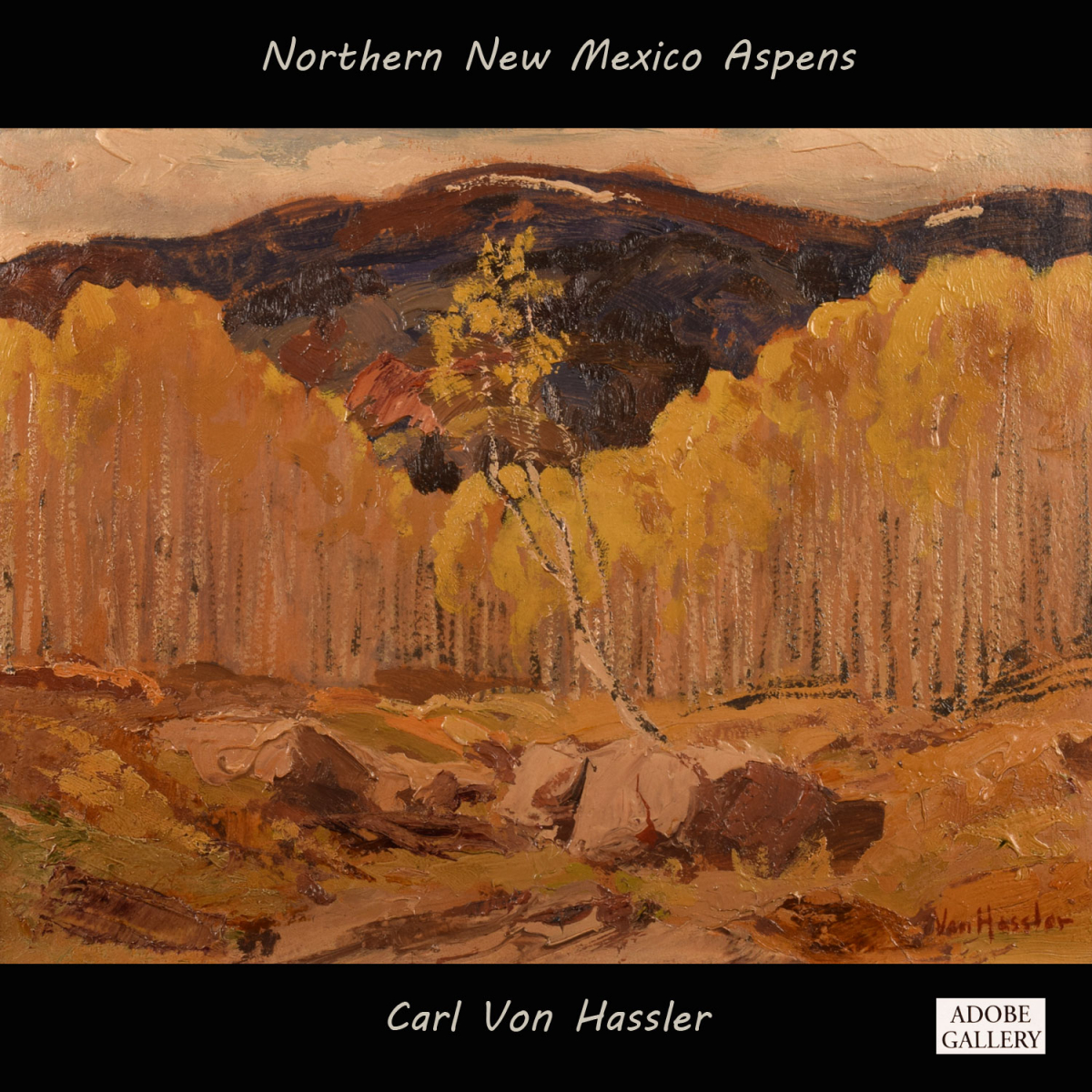
Item # 20516 Original Oil Painting "Northern New Mexico Aspens"
Carl Von Hassler, Southwest Painter
oil on board
11 x 14 inches (L x W)
This oil painting, titled Northern New Mexico Aspens, was made by Albuquerque artist Carl Von Hassler. It is without a doubt one of the finest Von Hassler paintings we have handled over the years. The piece depicts the Sangre de Cristo Mountains north of Santa Fe near the Tesuque River. Carl Von Hassler often painted on site in areas in Northern New Mexico. He particularly liked the small Northern New Mexico villages between Santa Fe and Taos. His affinity for the region is evident in this excellent painting.
Von Hassler used a combination of paintbrush and palette knife in this painting, resulting in a richly textured image. In the foreground, we see a cluster of rocks in a dry riverbed, with a single Aspen emerging. This central area is where Von Hassler varies from his norm most significantly. Thick streaks of paint create an impression of each rock, before combining with other colors to create the impression of the group. We see hints of this sort of work in his other paintings, but it's rarely as dramatic as it is here. It works wonderfully, and the earthy fall tones amplify the effects of the brushwork. In the background, we see a field of Aspens and a mountain ridge. These distant forms look more like what we expect of Von Hassler while still maintaining the dreamlike feel of the central area. When viewed from a distance, the scene looks quite realistic; this reminds the viewer that Von Hassler knew exactly what he was doing when he created this wonderful painting.
This painting is not dated. It is signed Von Hassler in lower right.
Carl Von Hassler (1887-1969), an artist who moved to New Mexico in the early 1920s, was known as the Dean of the Albuquerque Art Colony. Born in Bremen, Germany, Von Hassler attended the Dusseldorf Art Academy. When he came to the United States, he lived for a while in Greenwich Village in New York and was a member of the famed painters who called themselves the Greenwich Ash Can Group. In the years since his passing, he has come to be regarded as one of the best and most collectible Albuquerque artists. His works are included in many prominent public and private collections and have been exhibited in museums around the Southwest. In his early years in Albuquerque, Von Hassler's studio was in the original Casa de Armijo (now La Placita Restaurant) in Albuquerque's Old Town. He was best known for his traditional realistic landscapes of New Mexico and his Indian portraits.
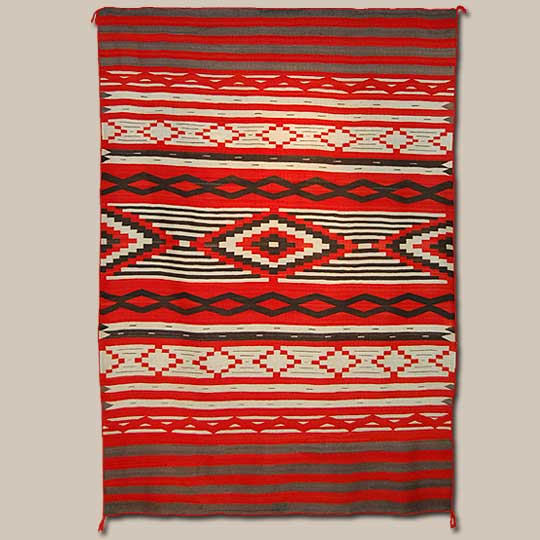
Item # 24162 J. B. Moore Plate II Variant Crystal Trading Post Navajo Rug
Unknown Diné Weaver
Native Wool
94 x 64 inches (L x W)
J. B. Moore, Trader at Crystal Trading Post in New Mexico from 1900 to 1911 is now famous for introducing to the weavers new patterns of textiles he felt would be saleable to Easterners for use as rugs. His early examples, published in a 1903 catalog, were more like classic Navajo textiles and those published in a 1911 catalog were more like Persian rugs.
It was his intent to have weavers make rugs that looked familiar to Easterners. They were then using Persian carpets, so his patterns were made to be similar. His idea worked and established a market for the Navajo women’s work. Almost 100 years later, some of these rugs are still in use. This one is an example of the durability of Moore’s product and the beauty of his designs.
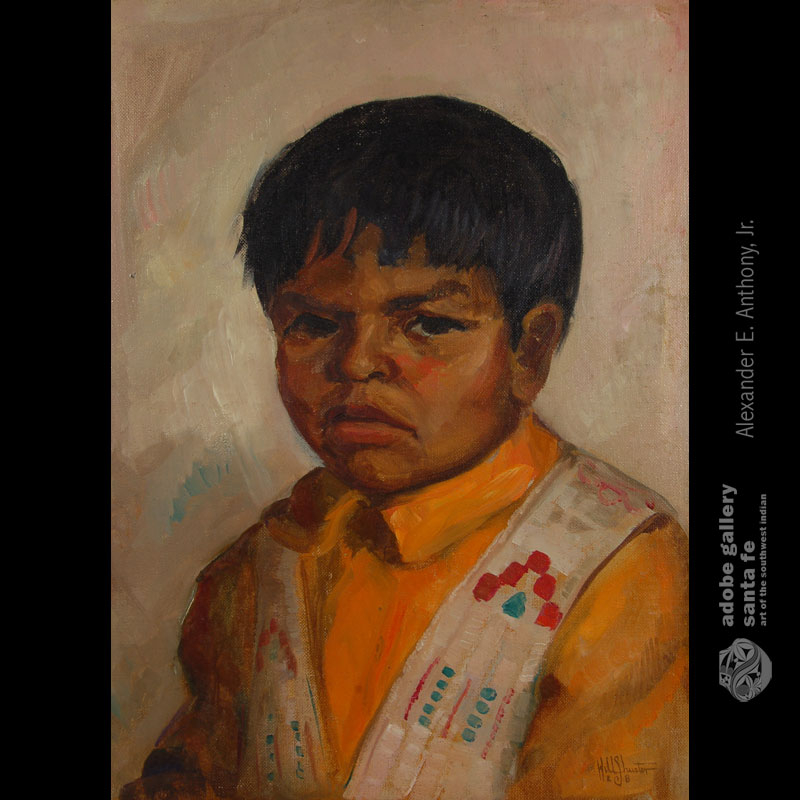
Item # 25320 Original Oil Painting of By-o-toi-ti Summer Bird
William Howard Shuster
Oil on Artist Canvas Board
16 x 12 inches (L x W)
By-o-toi-ti was a young lad from San Ildefonso Pueblo that Will Shuster chose as a subject for this painting in 1928. It is an extraordinary portrait of the young boy. I think the boy was less than enthusiastic about dressing up and posing for the painting. His almost pouting expression is part of the charm.
A realist and early modernist painter, graphic artist, illustrator, and sculptor, Will Shuster became known primarily for his work in New Mexico where, in 1920, he settled in Santa Fe, having been encouraged to come there by John Sloan. He had studied electrical engineering at the Drexel Institute in Philadelphia and later was a student of Sloan's in Santa Fe in both etching and painting.
He was in World War I, where he suffered a gas attack. On his return, he was advised by his doctor to go west for his health.
In Santa Fe in 1921, he became one of the founding members of Los Cinco Pintores, artists who responded to the New Mexico environment including the Penitentes in a respectful way and modernist, abstract style. Shuster never really adopted the modernist style of his contemporaries, but, rather, followed the realist style of his mentor, John Sloan.
This Original Oil Painting of By-o-toi-ti Summer Bird by Will Shuster is signed Will Shuster in lower right and dated 28. It appears to be in the original frame and is in overall excellent condition.
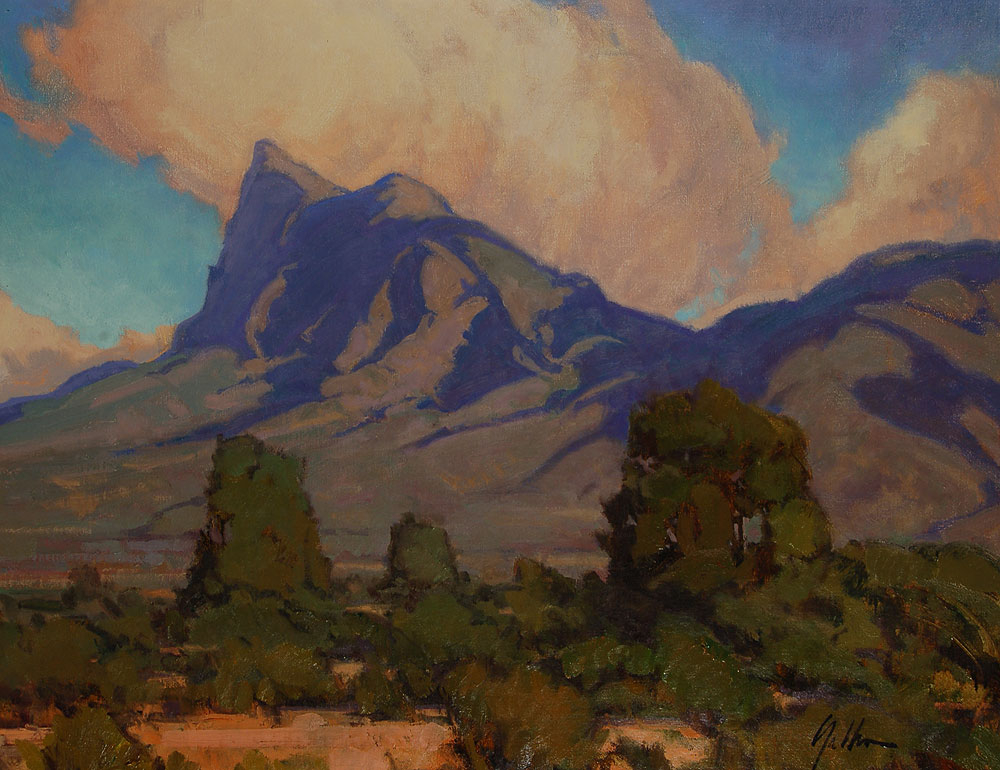
Item # 25359 Original Oil on Linen “Song of the Titans”
William P. Gallen (1958- ) Bill Gallen
Oil on Mounted Linen
24 x 30 inches (L x W)
This original painting by Bill Gallen, titled "Song of the Titans," is a painting of the Picacho Mountains in Arizona. Gallen deliberately paints in restrained color and detail as a means of enlivening the natural rhythms of the subject, and to keep his paintings from appearing as illustrations. The softness of his techniques casts a warm and relaxing mood to his paintings. "Song of the Titans" was painted in 2009. It is signed by the artist in lower right and dated and titled on verso. It is beautifully framed in a gold metal leaf wood frame and ready to hang.
Gallen stated “Painting for me is a world where, time after time, the ripeness and richness of life is revealed in the simplest of expressions. A path through barren autumn scrub is material enough for a painting. Translating the thrill of seeing—and responding in paint language—is the way and means of our craft. No grand vista is needed to discover a sacred world; one lies before us already.”
William (Bill) Gallen (1958- ) is a painter who resides in Santa Fe, New Mexico. Growing up along the shores of Lake Michigan and wandering the woods and fields of his native Wisconsin gave Gallen an early appreciation for the wonders of the natural world. Gallen graduated from the University of Wisconsin, having studied German and History and spent a year abroad at the University of Freiburg in Germany. Plans to pursue an academic career gave way when he moved to Colorado with his brother, following the call of a boyhood interest in the Rocky Mountains. Nurturing a lifelong interest in art, Gallen studied painting and drawing in his free time. Fortuitous encounters with the landscape painter David Ballew lead him to a lineage of teachers that remain lifelong friends, principally Michael Lynch, Ned Jacob and Chuck Volz. Gallen enjoys painting landscapes, particularly location pieces. The eye for beauty and harmony in nature, which he developed as a child in the Midwest, informs his work with freshness and sensitivity. Gallen's paintings are included in private, corporate and museum collections nationwide.
*bio courtesy the artist's website

Item # 26214 Santa Clara Pueblo Painting of Tewa Clown
Pablita Velarde (1918-2006) Tse Tsan - Golden Dawn
Mineral earth pigments on board
23.25 x 11.75 inches (L x W)
This mineral earth painting of a Tewa clown was created by Santa Clara Pueblo artist Pablita Velarde. The artist is known for images like this one—realistic depictions of Pueblo ceremonial scenes. Her subject here, the Tewa clown, is a common one for the early pueblo painters. With this image, Velarde used just five colors to create a clown. It would be accurate to describe the colors as “earthy,” especially when the actual source materials are taken into consideration. The clown is depicted in motion, with his head turned upward and his mouth open. Velarde’s outlines are minimal, and there is little in the way of extraneous detail. Everything about the image is simple and strong. The top of the clown’s headpiece touches the top border, and his toe nearly touches the bottom. He occupies most of the long, thin board, creating a striking presentation out of simple, natural materials. This is another wonderful piece from pioneering pueblo artist Pablita Velarde.
The painting is signed Pablita Velarde in lower right. It is framed in a simple, wooden, likely original frame.
Pablita Velarde (1918-2006) Tse Tsan - Golden Dawn was an innovative and influential artist from Santa Clara Pueblo. Velarde was the first full-time female student in Dorothy Dunn's art class at the Santa Fe Indian School, where she studied alongside Tonita Peña. These two women are regarded as the first Native American women to support themselves as painters, but it is not just because of this that they are remembered so fondly. It is because of the quality of their works that they have remained so visible in the many years since they passed.
Velarde painted in the traditional style of the Santa Fe Indian School, creating accurate portraits of Native American life and culture. At first, she worked in watercolor, but later learned how to prepare paints from natural pigments—a process called “Fresco Secco.” She is best known for these mineral earth paintings. She would grind mineral and rock elements using a metate and mano until the result was a powdery substance. From this substance her paints were made. She also painted on paper, often using casein in addition to earth pigments. She was also known to create art derived from the Navajo sandpainting tradition. Velarde’s list of accomplishments and accolades is long and varied. Her works have been exhibited around the country and are included in many prestigious public and private collections. Author and anthropologist Clara Lee Tanner called her the “greatest woman artist in the Southwest.” Her daughter Helen Hardin and her granddaughter Margaret Bagshaw were themselves highly successful and influential painters, creating an artistic dynasty.
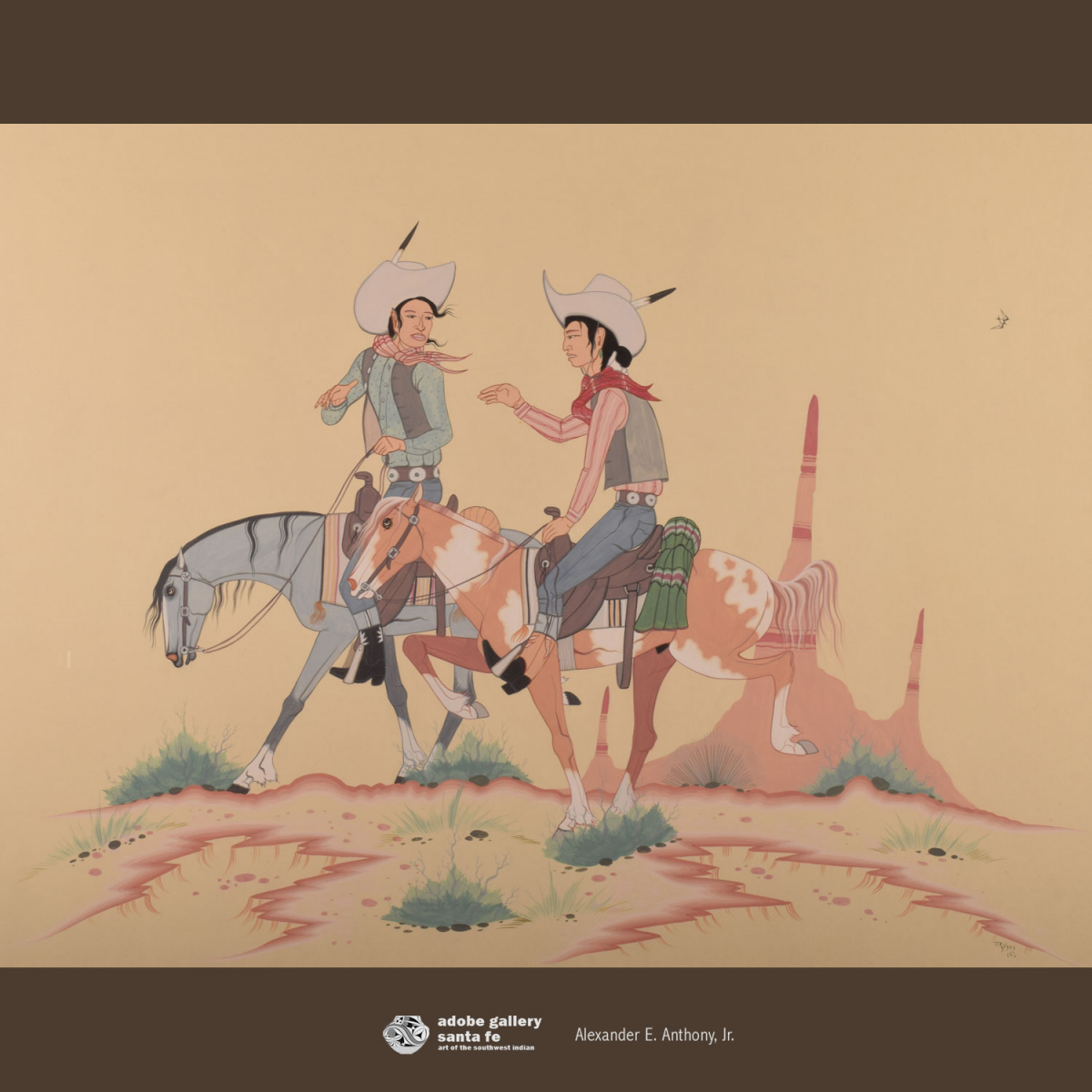
Item # C3242A Original Navajo Painting “Going to the Rodeo”
Beatien Yazz, Navajo Nation Painter
Casein
20 x 26 inches (L x W)
No other artist portrayed the daily activities of the Diné as well as Beatien Yazz. He grew up on the Navajo Reservation and was remarkably familiar with the daily activities. He always portrayed them with young features in a grown-up appearance.
This painting of two young Navajo men, casually riding their horses and chatting while on their way to the rodeo, is presented in Yazz's traditional style. Each is dressed in traditional garb of the times—cowboy boots, vest over the shirt, concha belt, Levi trousers, neck scarf and a large cowboy hat. His use of soft, almost pastel, paints blends the subjects well into the desert landscape. The lack of background subjects, except for the single rock formation, reinforces the starkness of the desert.
The Original Navajo Painting "Going to the Rodeo" by Beatien Yazz is an extraordinary example of the artist at his best.
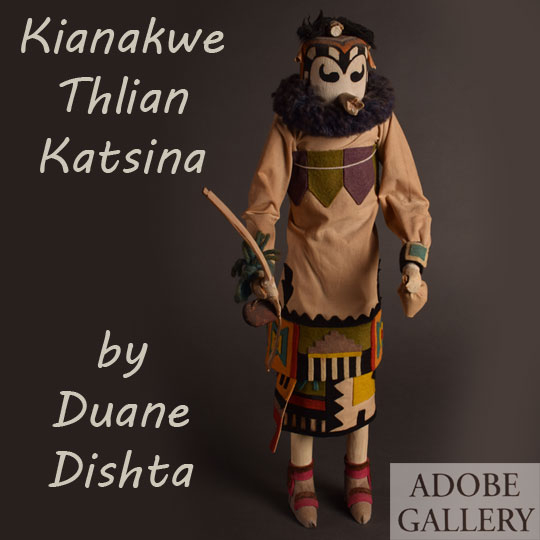
Item # C3535.61 Zuni Pueblo Kianakwe Thlian Katsina Doll
Duane Dishta
Wood, fabric, turquoise, yarn
This Zuni Pueblo Kianakwe Thlian Katsina Doll was made by talented painter and carver Duane Dishta. Most of his early dolls are recognizable and very collectible for their intricate detail and accuracy of the spirit beings of the Pueblo religion.
One of the oldest of Zuni Pueblo legends describes how the Zuni people overtook and conquered their enemy, the Kainakwe, a group of Indians far to the South. In observance of this event, the Zuni perform a one-day dance called the Kianakwe Ceremony that follows an eight-day retreat. It is unique in that it is performed only by the Corn Clan and is a dance involving the distribution of large amounts of food and goods.
The ceremony begins ten days prior to the final-day dance when the impersonators go into the kiva to paint and prepare the masks. The public performance begins when they enter the plaza early in the morning and begin the first of four dances that continue throughout the day and end just at dusk, at which time they fling the quantities of food and goods to the populace. The Kianakwe then exit to the west.
The above information was excerpted from the out-of-print book Kachinas of the Zuni by Barton Wright with original paintings provided by Duane Dishta. A much more detailed explanation of this Zuni Katsina may be found in the book. This Katsina doll is not signed, but was shown to Dishta who identified it as one he made in the late 1960s.
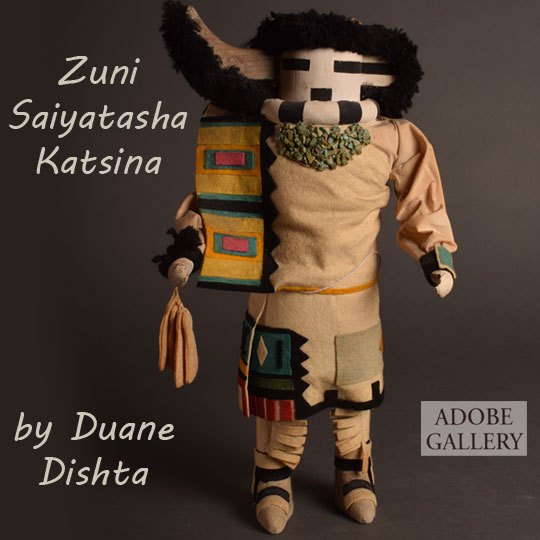
Item # C3535.62 Zuni Long Horn Priest of the North, Saiyatasha Katsina Doll
Duane Dishta
Cottonwood Root, fabric, turquoise, yarn
This Zuni Long Horn Priest of the North, Saiyatasha Katsina Doll was made by talented painter and carver Duane Dishta. Most of his early dolls are recognizable and very collectible for their intricate detail and accuracy of the spirit beings of the Pueblo religion.
Saiyatasha, the Rain Priest of the North, is an important katsina whose only appearance is in the Shalako Ceremony. It is he who controls the weather, provides longevity to the people and protection from their enemies. Zuni informants once described his function as bringing long life to the Zuni people. His short right eye is to make the lives of the witches short and his long left eye is to provide for long life for the good people.
During his period of impersonating Saiyatasha, the Zuni man holds a position of great responsibility, power and prestige and assumes the rank and importance of one of the major priests of Zuni. It is he who must decide the ceremonial calendar for the year and must watch over the phases of the moon for the full year. He sets the date of the Shalako Ceremonies and insures that they do not conflict with other ceremonial events. He must learn all of the lengthy prayers, chants, and speeches while attending nightly meetings that last from the Zuni New Year until Shalako. In addition, he is required to make journeys to springs from four to eight miles distant to offer prayers each month during the year. He must also pray to the sun each day and work to prevent the frosts of spring and fall since he represents a katsina who makes the days warm.
The above information was excerpted from the out-of-print book Kachinas of the Zuni by Barton Wright with original paintings provided by Duane Dishta. This Zuni Long Horn Priest of the North - Saiyatasha Katsina Doll is not signed, but was shown to Dishta who identified it as one he made in the late 1960s.
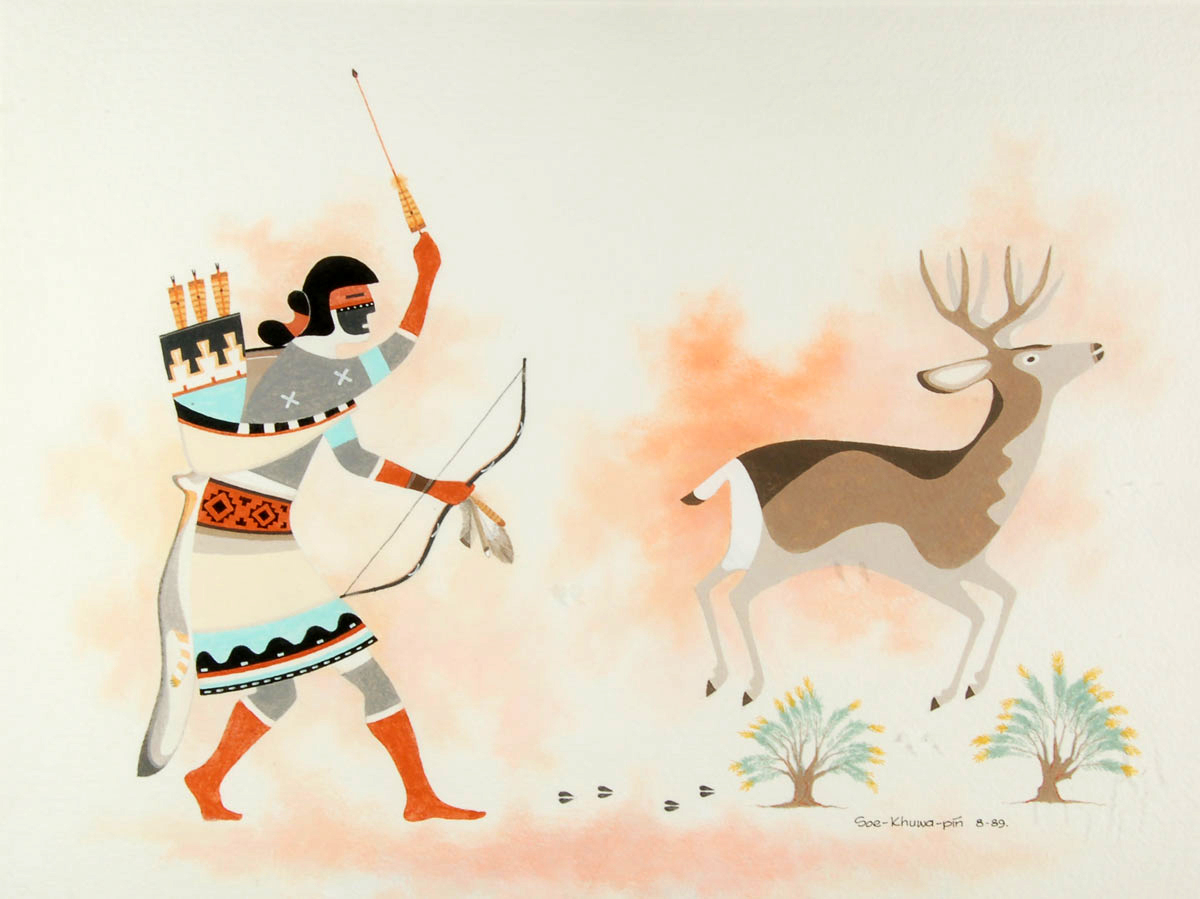
Item # C3808E Original San Juan Pueblo Painting of a Deer Hunter and Deer
Robert Montoya (1947- ) Soe Khuwa Pin - Fog Mountain
casein
11 x 14.5 inches (L x W)
It is rare to see a hunt scene from a San Juan Pueblo artist. Diné artists seem to have favored hunt scenes, but theirs were quite different than this. Theirs were very realistic and occasionally violent. This painting by Robert Montoya is as gentle as a hunt scene could be. Clouds of bright orange decorate the hunter and animal's surroundings, adding to the painting's dreamlike feel. It is always a treat to see a unique, personalized twist on the traditional pueblo style.
This painting was created by Ohkay Owingeh Pueblo artist and achitect Robert Montoya. With this piece, the artist presents a unique, modern variation of the traditional pueblo "flat" style. Montoya's human figure is dressed in ceremonial clothing and pictured in profile, which aligns with what we'd expect of a traditional painting. The composition style varies from tradition, as the figure is formed out of blocks of color rather than defined by thin, bold outlines. The deer is similarly composed.
Robert Montoya was born in 1947, and is the son of Ohkay Owingeh painter and former Santa Fe Indian School art department head, Gerónima Cruz Montoya. Mrs. Montoya began her teaching career as assistant to Dorothy Dunn. Robert Montoya has multiple degrees in architecture and also has experience as an architect. He resides at Sandia Pueblo. Robert is not a prolific painter, as his career in architecture occupies most of his time.
The Original San Juan Pueblo Painting of a Deer Hunter and Deer by Robert Montoya is signed in lower right with the artist’s native name and dated 8-89. It is properly framed and in original condition.
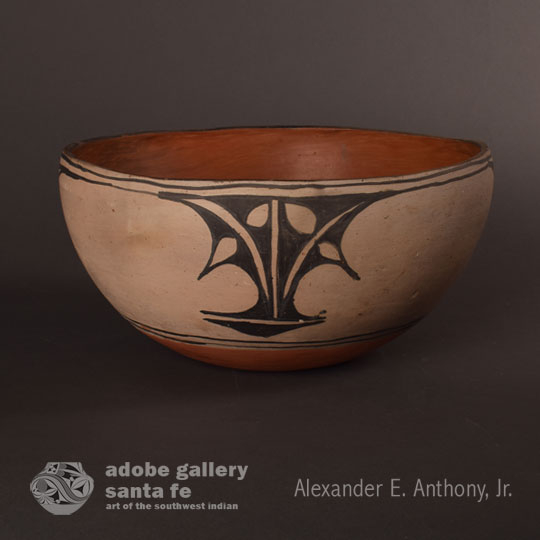
Item # C3862H Historic Cochiti Pueblo Large Pottery Serving Bowl
Unknown Native Artist
clay, pigment
If you were ever invited to share a meal at a pueblo home, you would have seen vegetables or red chile or green chile stew served in a bowl like this. Such bowls grace the table at all pueblo meals. This historic bowl, however, shows no evidence of use so you could be the first to put it to use on your table. Bowls of this size are also used when making small amounts of loaf bread.
This Cochiti Pueblo Large Serving Bowl has a beautiful shape. The wall curves inward as it rises from the mid-body. The rim is painted black and exhibits a ceremonial line break which extends downward breaking the continuity of the design chain.
The design is typically a rain cloud presentation seen on many Cochiti vessels. Three of the designs have a single rain cloud at the bottom of the design. The fourth design has a pair of rain clouds because that design panel is divided by the ceremonial break. Cochiti is one of the pueblos which has no restriction on using water symbols on secular pottery. Their neighbor, Kewa Pueblo - Santo Domingo Pueblo, strictly forbids use of such on its pottery. It is estimated that the bowl dates to the end of the historic period, circa 1940s, or early in the contemporary period, post 1940s.
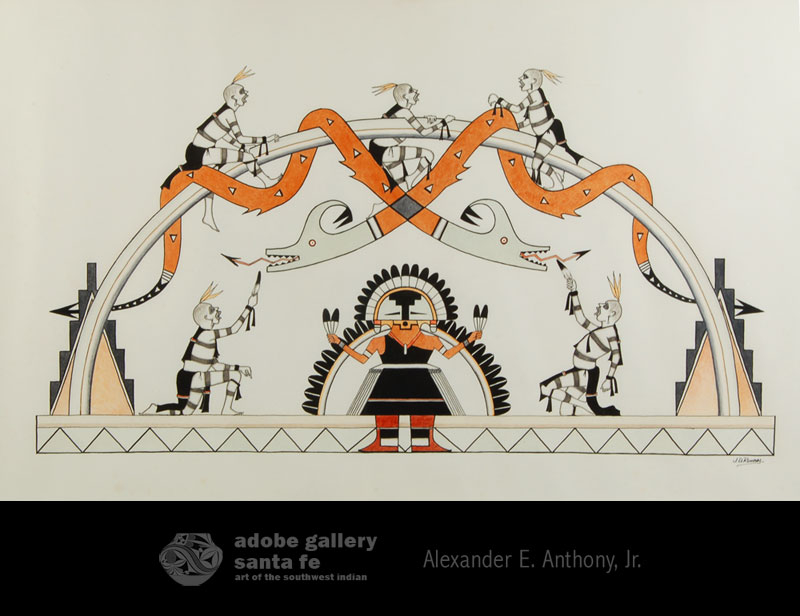
Item # C3874H San Ildefonso Pueblo Painting of Koosa Clowns and Avanyu on Rainbow
José Disiderio “J. D.” Roybal (1922-1978) Oquwa - Rain God
multi-medium
13.5 x 21.75 inches (L x W)
San Ildefonso Pueblo artist J.D. Roybal is best known for his portrayal of the Koshari or Koosa Clowns. His paintings present traditional pueblo ceremonies and legends in a realistic and symbolic manner, often with added touches of humor. In this painting, Koosa Clowns are cavorting with Avanyu, who are wrapped around a rainbow. The Avanyu are offering blessings to the Koosa.
The Koosa Clowns on the rainbow and those below suggests much joviality in their actions and facial expressions. The female figure in the center of the painting has the appearance of a Katsina, however, I do not know the explanation for her. The painting by José Disiderio (J.D.) Roybal [1922-1978] Oquwa - Rain God is circa 1950s.
The painting prevails in excellent detail, small and fine outlines, gesturing figures and a wonderful combination of ritual and humor. The color palette is beautifully controlled. This painting of Koosa Clowns and Avanyu on a Rainbow over a Female Figure is certainly one of his most unusual.
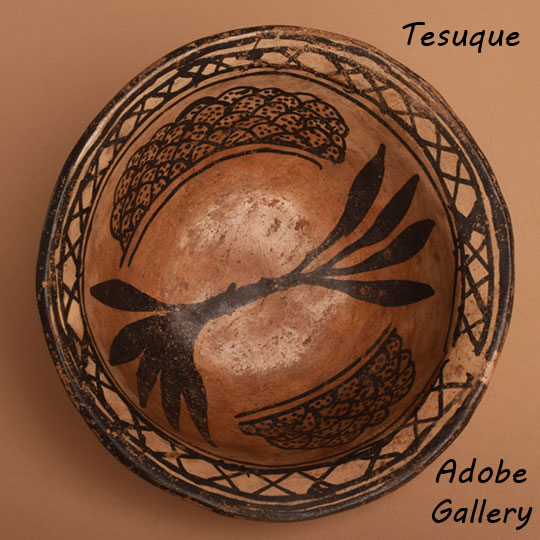
Item # C3926J RARE Tesuque Pueblo Small Pottery Bowl with Interior Design
Unknown Native Artist
clay, pigment
Documentation applied to pottery by a purchaser is invaluable information, even if it is incorrect. This bowl that was made at Tesuque Pueblo in the late 1800s, must have ended up at Fort Wingate, near Gallup, New Mexico, because that is the likely location from which the purchaser acquired it. Beautifully written in cursive script on a paper attached to the base is “Navajoe Pottery from Fort Wingate New Mexico”.
The history of the bowl is somewhat revealed by that simple note attached to the base. It provides us with the location from which it was purchased. It sheds light on the travels the bowl made from Tesuque or Santa Fe to Gallup. Perhaps the commissary at Fort Wingate stocked such items for the soldiers and their families. Possibly even Jake Gold, Santa Fe merchant, provided pottery and other items to the fort.
The bowl is of the style from the 1880s era with its rolled-out rim. The interior is decorated with stacks of billowing clouds on the interior wall and a leafy plant rising from the bottom of the bowl. The rim is filled with a band of X elements through which is a ceremonial line break. The exterior of the bowl is undecorated but has a one-inch-wide red band wiped on at the rim.
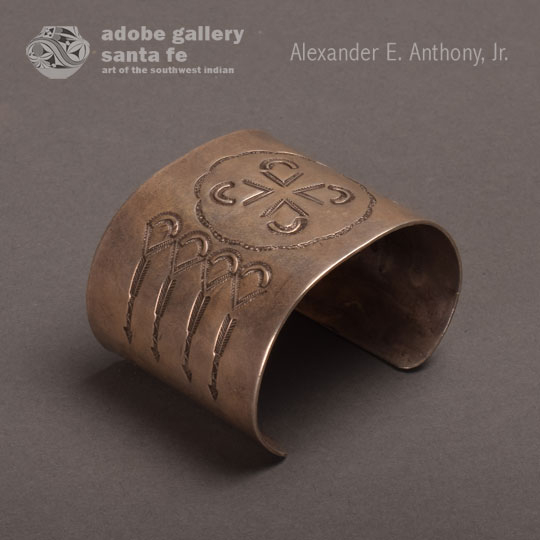
Item # C4069U Navajo Wide Silver Cuff with Medallion and Arrows Symbology
Unknown Native Artist
Sterling Silver
An unknown Diné silversmith employed the inventive use of stamps to fabricate this amazing Navajo Wide Silver Cuff with Medallion and Arrows Symbology. Using only four distinctive stamps, the talented smith created a series of intricate design elements.
For the center, the artist used a series of crescents and V shapes to fashion a circular medallion motif. The same elements, along with the addition of arrows, were used on the sides of the bracelet. It is a symmetrical and stylish piece of Southwest Indian Jewelry.
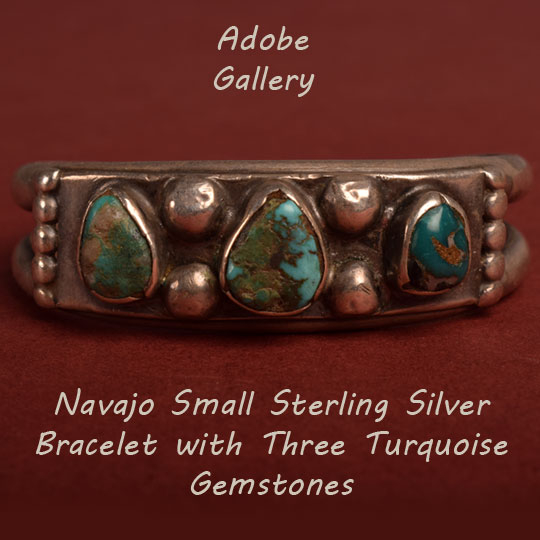
Item # C4103.28 Navajo Small Sterling Silver Bracelet with Three Turquoise Gemstones
Unknown Native Artist
Sterling Silver, Turquoise
This lady's small bracelet dates from the early 20th century. It contains three turquoise gemstones, each with its own unique quality. The dark green stone has small portions that have been filled in with gold, silver and a black substance for a smooth finsih. Under a loop, the gold sparkles. The other two turquoise gemtones have an interesting brown matrix. All three gemstones are set in bezels which have similar file work in the same three areas on each cabochon. At first the bezels look damaged, but it is apparent they are all cut in the same three places on each gemstone, so the cuts are intentional. The three turquoise gemstones are attached to a silver sheet that is adorned with multiple silver drops that are interspersed between the turquoise. The completed design area is attached to two silver bands. The Navajo bracelet is quite old and shows a considerable wear pattern.
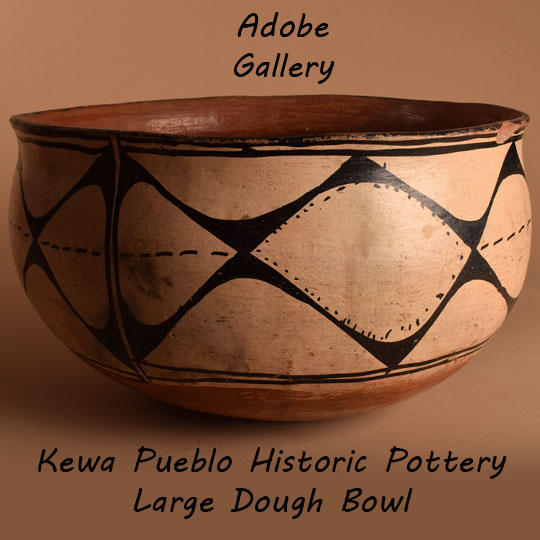
Item # C4119A Kewa Pueblo Historic Pottery Large Utilitarian Dough Bowl
Unknown Native Artist
clay, pigment
Well-crafted and beautifully-decorated pottery has always been part of the pueblo aesthetic. It was not until the late 19th century that potters started adhering to the unfamiliar tastes of the Western eye. It was of necessity to do this in order to make a sale. This has not changed even today. Potters produce what they know will sell to the non-Indian market.
This dough bowl, however, speaks loudly of the pueblo aesthetic. It was made for, designed by and used by a pueblo potter. It was made in the vessel shape that was needed for a particular use and designed with a traditional Kewa Pueblo design which could have been passed down in the same family of potters for decades. It is because of these reasons that this bowl becomes such a collectible treasure. It was beautifully shaped and expertly painted. It is possible that it may have been used for several decades before leaving the pueblo.
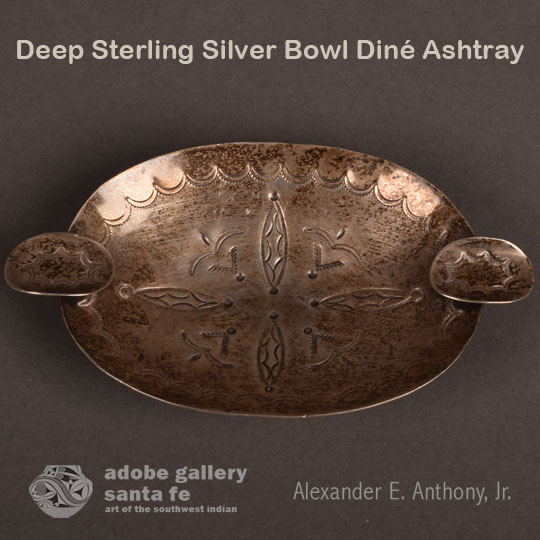
Item # C4281.47 Deep Sterling Silver Bowl Diné Stamped Tray
Unknown Native Artist
sterling silver
This sterling silver ashtray dates from the mid twentieth century and was made by a Diné craftsman. It has a deep bowl that is elevated on four curved silver wire legs. There are two cigarette holders. The deep bowl was decorated with traditional Diné jewelry stamps—ovals, arches, and parallel lines. Around the edge of the bowl is a continuous line of semicircles with short sunrays. The cigarette holders were stamped with an oval comprised of similar semicircles.
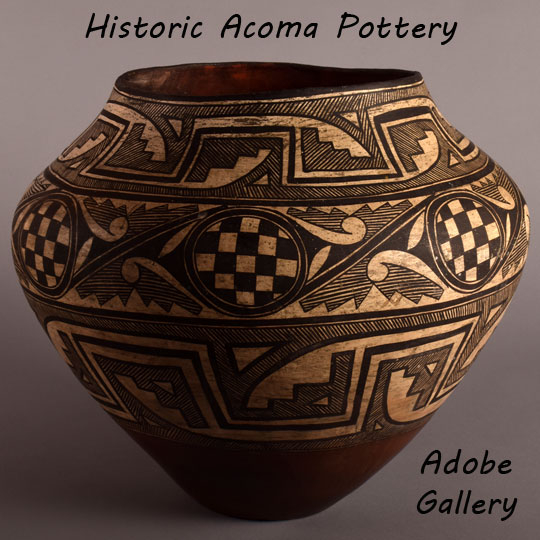
Item # C4283A Historic Acoma Pueblo Pottery Water Jar with Polychrome Bird Designs
Unknown Native Artist
clay, pigment
14 x 15 inches (L x W)
The best way to start the description of this Acoma Pueblo pottery jar is to simply say it is magnificent. It is large in size and unique in design. It originally was in the collection of Santa Fe dealer and collector Marti Struever, having been photographed with her in 1975. It is one of three historic jars in Marti’s collection when she passed away 3 years ago. Information regarding it was presented in an insurance appraisal in 2018 in which the appraiser stated “According to Marty (sic) this olla was created by a literal marriage between a Zuni and Acoma family; the Zuni rainbird lines with the strong, high shoulders of Acoma.”
To start with the shoulder designs, we see circles with checkerboards. According to Harlow and Lanmon (2013:263), checkerboards on Acoma pottery first appeared about 1780-1800 and on Zuni pottery shortly after 1750, so we see there is a history of the use of that design by potters at both pueblos. Harlow and Lanmon also state that checkerboards appeared on roughly 25% of all Acoma jars by 1920. It would be acceptable to state that this jar dates to 1890-1910 and is the work of a family of Acoma and Zuni artists. The clay is of Acoma origin and the design has strong Zuni influences.
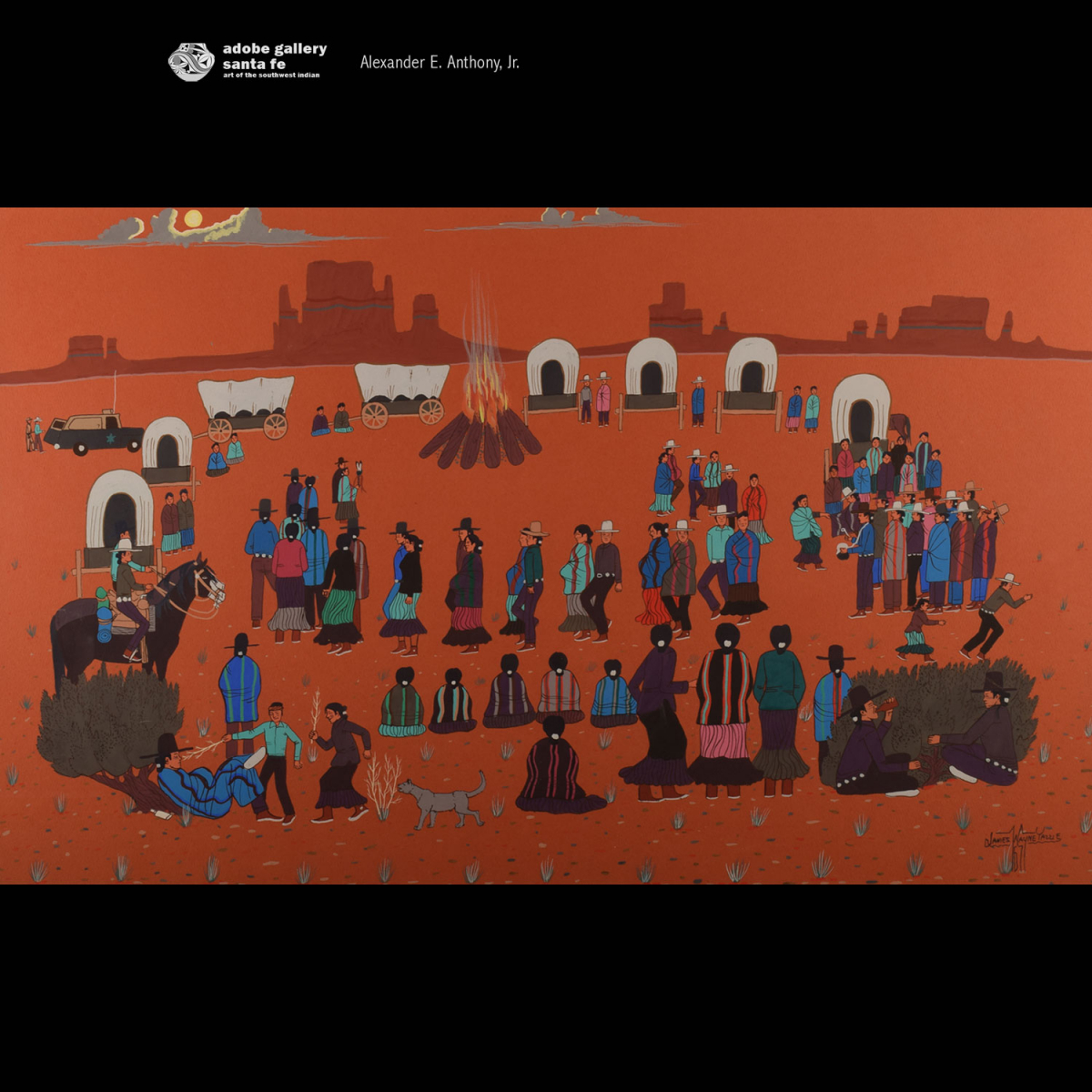
Item # C4320 Untitled Navajo Painting of Round Dance
James Wayne Yazzie, Navajo Painter
Casein
19.5 x 31.25 inches (L x W)
This large painting of a Navajo ceremony was created by Diné artist James Wayne Yazzie. We've only seen one other piece by this artist-a similarly sized piece with a similar ceremonial theme. The difference, though, is significant-that previous listing used just a few colors, and this one is bold and colorful. A Diné friend of the gallery who knows these ceremonies very well provided us with a description of what's occurring in this painting: "The painting depicts the round dance of the enemy-way ceremony. The enemy-way ceremony is only conducted during the summer season. The 4-day ceremony treats a patient who is affected by the spirits of enemies with whom they come in contact, usually from war. At most times, the ceremony emphasizes rites of going to battle. The ceremonial staff represents the scalp of a slain enemy, it contains the illness from the patient. During the round dance, a girl is often carrying the staff. It represents astaan' nadgleeh', praising her trophy scalp given to her by naayeenezghani and to'baadnichini'-her twin children who slayed the monsters."
Yazzie's round dance scene includes dozens of figures, as well as stagecoaches, horses, a police car, a fire, and a variety of plants. Its most immediately appealing characteristic is its coloration-a large palette of bold, bright tones painted onto paper that falls somewhere between red and orange. Yazzie's blues, greens and purples give the image a vibrant energy. Standing in strong contrast to these tones is the orange-red paper, which represents the arid but beautiful desert landscape. The ceremony is, of course, the main event, but there is much more to see here. Children with sticks bother a sleeping man, two men share a drink behind a tall bush, a man is hauled off to a police cruiser-all of these details are wonderful. Yazzie painted a ceremonial scene, as Native artists do, but he managed to include some things tastefully and effectively we do not often see in works from this era. These details-all the activity outside of the main event-give the viewer a more accurate look at the realities of life on the reservation. This painting is one of the most rare and exciting Native paintings we have handled recently. Yazzie, unfortunately, had a noticeably short life. When looking at this piece, one wonders what he might have accomplished had he lived longer. This is a special piece that is overflowing with warmth, humor, and humanity.
The painting is signed and dated “James Wayne Yazzie ‘67” in lower right. It is framed underneath brown matting in a wood frame.
James Wayne Yazzie (1943) was a "gifted and independent primitive" (Dunn 1968) who produced large arresting native scenes of the Navajo. Although self-taught, Yazzie used the Santa Fe Indian School Studio style in his art. Clara Lee Tanner's Southwest Indian Painting: A Changing Art provided a brief but complimentary bio about the artist: "James Wayne Yazzie, born in 1943, painted in water media and oils. Frequently there are many figures in a single painting. Frequently, too, there are touches of humor, such as a Navajo girl pulling a man out to dance with her, or where a woman in the foreground is pouring a dipper of water over a sleeping tribesman. Yazzie was killed in a train accident in 1969."
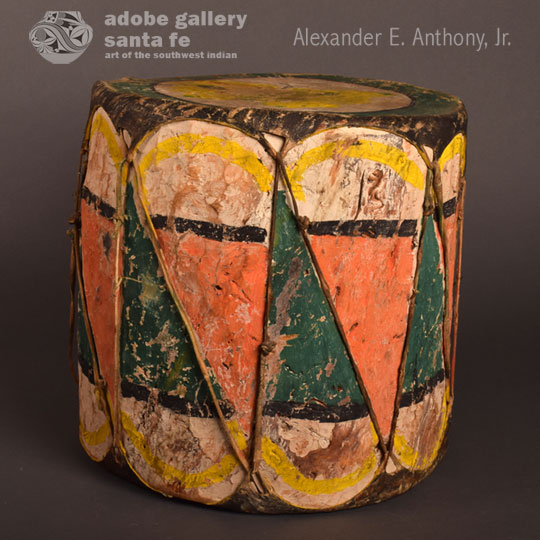
Item # C4330K Cochiti Pueblo Vintage Drum with Decorated Drum Heads
Unknown Native Artist
wood, hide, paint
This Cochiti Pueblo drum appears to have been made from an old and gnarled cottonwood trunk as there are irregularities in the wood that appear to have been there originally. The drum was painted in colors green , pink, white, black and yellow. There is an attached handle. One drum head was outlined in green paint with a black line separating the green from the unpainted center. What appears to be a yellow butterfly was painted on one drum head. The other drum head had a circle in the center from which are four tablita style elements in the four directions which are separated by groups of feathers. This was apparently the bottom drum head and most of the design has worn off. The drum head skin that overlaps on the side walls were painted black. This is surely a drum that saw extensive use.
Spaniards introduced two-headed drums used by the Pueblo Indians of New Mexico over 400 years ago. They are used for ceremonies and rarely for other purposes.
Native drums are generally used during traditional dances at many of the Pueblos located along the Rio Grande and its streams. The drum has played an intrinsic role in the lives of Native Peoples for centuries. Celebrations and ceremonial dances accompanied by the reverberating pulse of the drum.
Crafted from natural materials over a months-long process, American Indian drums are constructed of a wooden frame, or a carved and hollowed-out log. They can be natural or colorfully painted with solid colors or designs. Drum bodies are created from native woods of New Mexico such as cottonwood, aspen or pine. Drumheads are usually made from cow, deer, elk, goat, horse or buffalo hide stretched taut across the opening by sinew thongs. Traditionally, Native American drums are two to three feet in diameter.
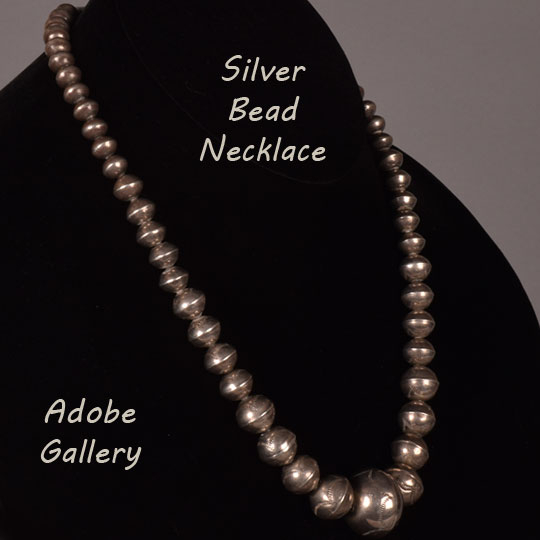
Item # C4353F Diné Handmade Silver Bead Necklace with Graduated Bead Sizes
Unknown Native Artist
silver
A Diné artist from the Navajo Nation made this mid-twentieth-century sterling silver necklace consisting of handmade graduated beads strung on a silver chain. Each bead was individually shaped and hand stamped with a crescent motif. Necklaces of silver beads are one of the most traditional styles of Southwestern jewelry, admired and collected by both Native and non-natives alike. Early twentieth century photos show both men and women wearing strands of silver beads.
This necklace was made of a lighter gauge silver than what was popular earlier in the twentieth century, giving it an ease of wear unlike earlier heavy necklaces. The lighter weight allows it to hang on the wearer’s neck with a graceful elegance. The shorter length makes this necklace very wearable as well as comfortable.
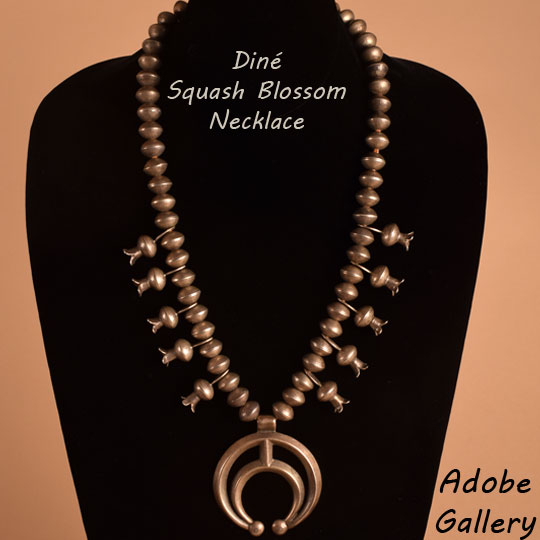
Item # C4353H Diné Squash Blossom Necklace made from U.S. Silver Coins
Unknown Native Artist
silver, U.S. coins, mother of pearl
The beads of this Navajo necklace were fashioned from vintage United States silver dimes from the early twentieth century. Each dime was hammered into a hemisphere and two dimes then soldered together, drilled to be strung on leather. Interspersed between the beads on the lower end are eight handmade squash blossoms, also fashioned from vintage dimes including the flat piece that is drilled and strung on the necklace. Pendant on the necklace is a cast silver naja with a stamped sun symbol at the tips. A single mother of pearl fetish is strung at the end of the necklace.
Jewelry manufactured in the very late 1960s and early 1970s by Diné silversmiths frequently used United States coins for adornment. It was a popular but short lived fad. A necklace such as this is quite heavy to wear for long periods. They have become collectible for display and for historical purposes.
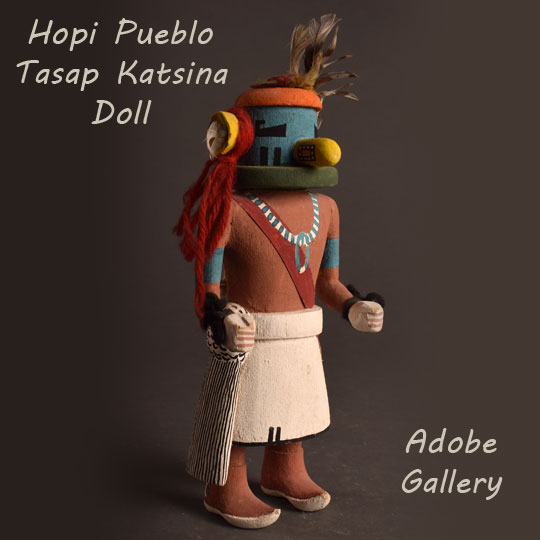
Item # C4365C Kachina Doll Hopi Pueblo Twentieth Century Tasap Katsina
Unknown Native Artist
wood, paint, yarn, feathers
Tasap is a Hopi representation of a Navajo God. There are Hopi versions of katsinam that honor and depict other tribes, such as the Navajo, Havasupai, Comanche, Zuni and other Pueblos. This Hopi Pueblo Katsina carving is in perfectly good scale and proportions imitating the body of a young man. It is above average for a late twentieth century carving. The torso is lean, the kilt hangs down to the knees as expected, the white sash was beautifully carved and painted and the moccasins executed in fine detail with slightly upturned toes. The carver has achieved the techniques of carving to scale.
This is the Hopi version of what the Navajo katsinam might look like. These katsinam are not borrowed from the Navajo, as they are unique to the Hopi. They have the same purpose and functions as all Hopi katsinam. They are messengers and/or intermediaries to the rain gods. Since they are katsinam in every respect, they are afforded the same reverence and dignity during their visits.
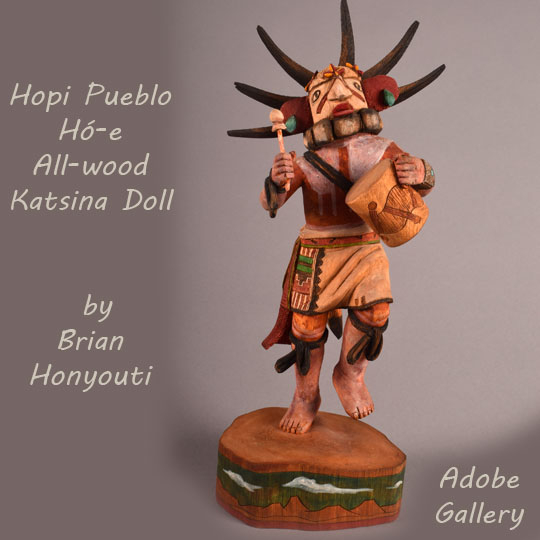
Item # C4383i Hopi Pueblo Hó-e All-wood Katsina Doll
Brian Honyouti, Hopi Pueblo Carver
wood, pigments
Hopi Pueblo artist Brian Honyouti presents us with his version of a Hó-e Katsina. It is an all-wood carving of exceptional quality. Hó-e is considered a clown and there are usually two or three of them in the procession of the Bean Dance as it proceeds around the village. The hand-carved wooden doll measures 8-⅛ inches from foot to top of head. The pigments used appear to be oil-based stains. He is dressed in a traditional Hopi embroidered kilt, cinched around his waist with a woven red belt. A fox tail is suspended down his backside from the waist belt. He has a spray of feathers like those of the Nataska Katsina and he carries a drum and drumstick. His face, chest, and arms are painted white and he has a green ruff around his neck.
“They are noisy, boisterous teases. One minute they will have organized a Plains Contest Dance that knocks the other kachinas about while the next moment they will have a foot race underway that will go right through the middle of a group of kachinas. They will tease the guards or lure the Kwikwilyaka into mocking one of the Angry Kachinas. Wherever they are, the uproar is continuous, and they are the last to give up and go into the kiva. Time and again the Guardian Kachinas must return to a plaza to make sure the Hó-e keep up with the procession as they get carried away with their fun. It is possible to follow their progress by watching the heads of the Hopi youngsters which point to them like a compass to the north pole.” [Wright, 1973:28]
Brian Honyouti had started carving katsina dolls in the 1960s after graduating from high school. He helped his dad paint his dolls and learned to carve his own at that time. According to Helga Teiwes (author), he was the first carver to use wood preservers and wood sealers as an undercoat for the carvings. She said he was also the first to substitute wood preserver for paint and to use oil paints in lieu of acrylic paints. These innovations provided a mellow tone to his carvings rather than the shiny gloss of acrylics.
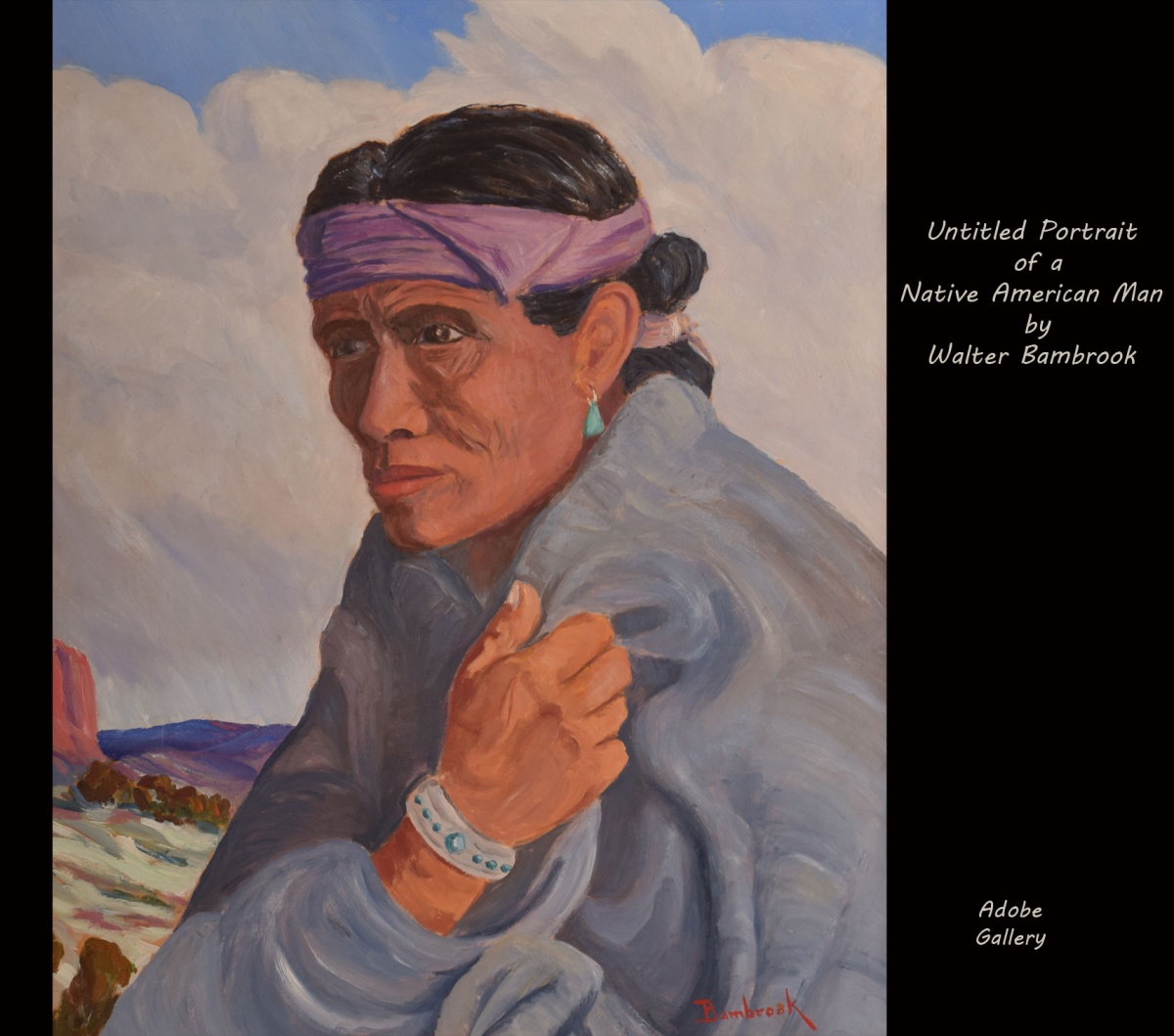
Item # C4399B Untitled Portrait of a Native American Man
Walter Bambrook, Western Painter
acrylic on board
16.5 x 13.5 inches (L x W)
This untitled portrait was painted by Albuquerque artist Walter Bambrook. It is a sweet image that will appeal to collectors with an appreciation for classic Western imagery. Bambrook’s subject here is a Native American man. He is wrapped in a blanket, shielding himself from the cold air. Streaks of white covering the ground behind him confirm that this is a winter scene. Behind him, a massive gray and white cloud formation fills the sky, coating the ground in the distance with a coat of white.
The man wears a silver and turquoise bracelet, an earring, and a purple headband. His strong facial features and deep-set brown tone lend him an appealing intensity. He stares off to the viewer’s left. Perhaps he is relieved that the storm has passed, or maybe he is facing another incoming cloud formation. We have handled many of Bambrook’s works over the years, but this is the first portrait we have seen. This is a pleasant deviation from the talented artist’s preferred subject.
The painting is signed Bambrook in lower right. It is framed in an elaborately designed gold frame.
Walter Bambrook (1910-1984) was a painter who lived and worked in Albuquerque, New Mexico. He attended Albuquerque High School and began his art education at the University of New Mexico (UNM) under the instruction of Ralph Douglas. While at UNM, Bambrook served as a printer's apprentice for the Albuquerque Journal newspaper and began his four-year art training under Carl Von Hassler. After his formal art education was completed, Bambrook taught many private classes and groups at UNM, the Woman's Club and Heights Community Club. He exhibited frequently and successfully during his career and placed his works in many prominent collections. Bambrook died on June 1, 1984 in Albuquerque, New Mexico.
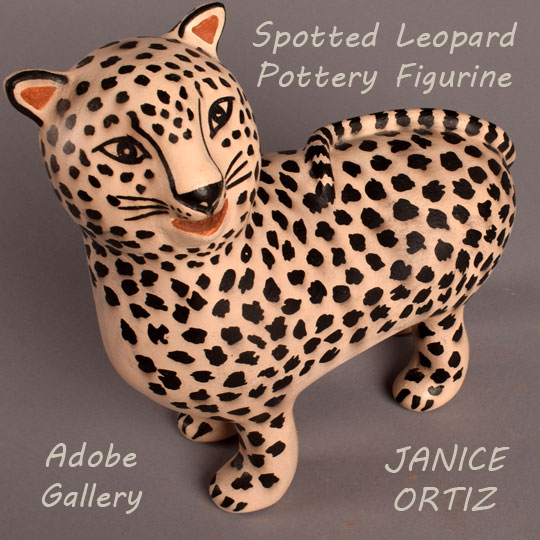
Item # C4401.24 JANICE ORTIZ Spotted Leopard Pottery Figurine
Janice Ortiz, Cochiti Pueblo Potter
clay, pigment
This pottery figurine is the most realistic presentation of a spotted leopard Adobe Gallery has seen. It was made by Cochiti Pueblo artist Janice Ortiz. Janice signs her pottery M. J. Ortiz because her name is Mary Janice Ortiz. That is the way her signature appears on this figurine. It was made in the year 2000, at which time we purchased it from her, sold it to a client immediately and now have it back from him to sell again.
Janice Ortiz (b.1954 ) is a daughter of Seferina Ortiz and sister of Virgil Ortiz. Janice’s grandmother was Laurencita Herrera and her great-grandmother was Reyes T. Romero. Janice says that she has been working with the clay since she was little. She joined her grandmother and mother when they were making pottery and learned from them. She has won numerous awards at Santa Fe Indian Market and the Heard Museum exhibits. If one judges her work from this figurine, it is easy to understand why she has been an award winner. It is in original condition.
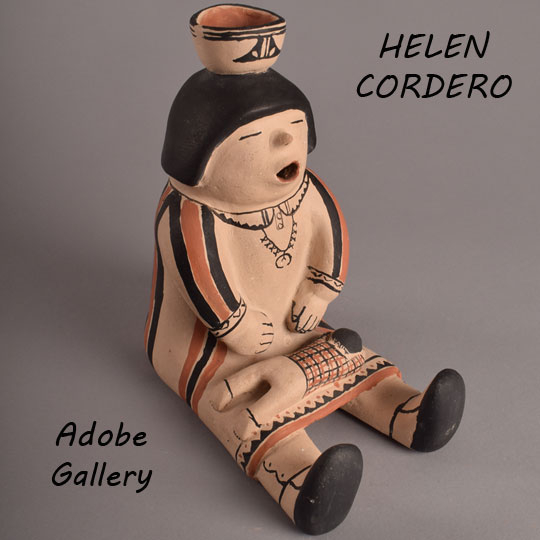
Item # C4408B Female with a Bowl on her Head and a Child on her Lap
Helen Cordero (1915-1994) Cochiti Pueblo
clay, pigment
10 x 5 x 9 inches (L x W x D)
The temptation may be to call this a storyteller figurine because she has a sleepy child on her lap, but artist Helen Cordero of Cochiti Pueblo emphatically stated that she only made male storytellers because they were modelled after her grandfather. This figurine would be labeled a female, perhaps a pot carrier.
She is dressed in a striped dress with a button collar and wears a squash blossom necklace. She is wearing the traditional white moccasins with leather leg wraps. On her head is a bowl and across her lap is a small boy. She is a fatter version than those made in the 1970s, and was probably made in the 1980s.
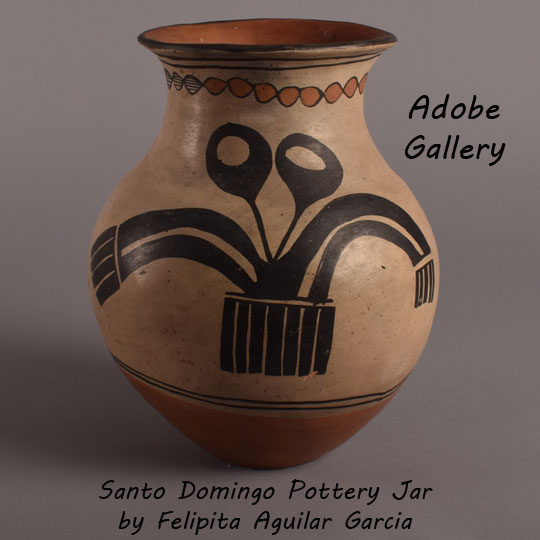
Item # C4417A Santo Domingo Pueblo Polychrome Pottery Jar with a Bold Design
Felipita Aguilar Garcia and Asuncion Aguilar Caté, Santo Domingo Pueblo
clay pigment
Rain symbols are often used on pottery; the artists are at once expressing gratitude and asking for more. Rain is very important to New Mexico and is always scarce, so a plea for help from the Great Spirit is understandable. This is a unique and wonderful Santo Domingo Pueblo Polychrome Pottery Jar with a Bold Design by Felipita Aguilar Garcia that may have had special significance to its desert-dwelling creator.
“Variations of the motif on this jar are common on early twentieth century ollas. In his unpublished notes, Kenneth Chapman recorded that this design was invented by a potter, with surname Garcia, between 1905-1910. [Batkin,1987:105] The time period, and Garcia name mentioned by Chapman, make it almost certain that he was speaking of Felipa Aguilar Garcia, one of the now-famous Aguilar sisters.
The striking design on the body of the vessel certainly relates to rain, clouds—water sources. The most prominent features are pairs of black lines curving up and out, increasing in width. These have been referred to as “spread-arm” designs. The small elements floating above and between these probably represent clouds, from which a heavy rain is falling.
Around the neck, the potter painted a necklace of small circles, some of which are filled with horizontal parallel black lines, and the others filled with an orange slip. Just below the outturned rim is a pair of framing lines with the traditional ceremonial line break. Another pair of framing lines circle the jar below the design area, but this pair does not have ceremonial line breaks.
The underside of the jar is concave, as is traditional for water jars. The lower part of the vessel is covered in red slip, as is the interior of the rim.
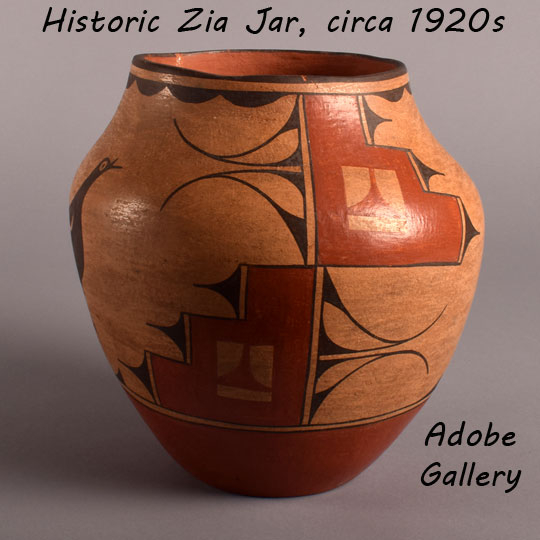
Item # C4417B Historic Zia Pueblo Pottery Jar with Birds and Capped Feathers, circa 1920s
Unknown Native Artist
clay, pigment
This circa 1920s jar from Zia Pueblo defies its age due its lack of traditional historic Zia Pueblo pottery designs covering most of the vessel surface. The potter chose to highlight her design with a Zia bird that is unique. I was unable to find a similar one in the Harlow and Lanmon book on Zia pottery. The bird has its wings tucked to its body rather that spread open over its back as most potters present. Also, the even and squared off tail feathers and the clacking beak are unique and not illustrated in published sources.
Her choice of the other design is a pair of capped feathers, one facing right and the other facing left. The triangle, without black outlining, represents the eye of a bird. The lack of outlining here is indicative of early twentieth century pottery from Zia. The black pair of curved elements represent leaves.
The open and uncluttered design and the minimalist bird should be clues to identifying the potter, but I could find no published examples that were like this one, so she will remain unknown.
The red slip on the underbody and on the capped feathers was stone polished, but that on the inner rim was left in a matte state.
Here we have a decidedly modern approach to a Zia jar that is otherwise traditional in all aspects of manufacture. The potter beautifully displayed her love of minimal design and open space. She achieved a remarkable result. This is an extraordinary work of art.
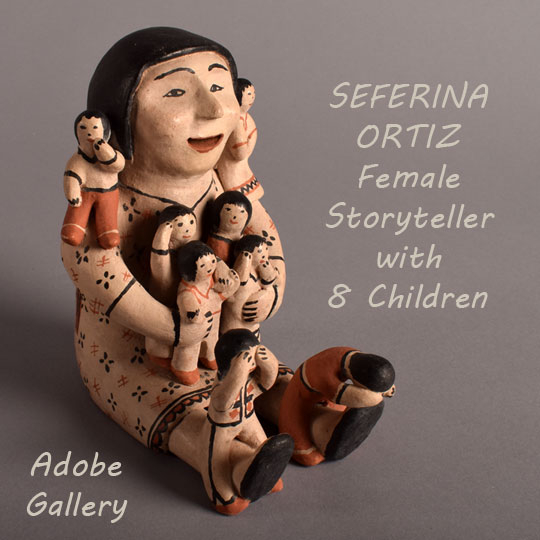
Item # C4421 Female Storyteller with 8 Children
Seferina Ortiz, Cochiti Pueblo Potter
clay, pigment
This pottery storyteller figurine by Cochiti Pueblo artist Seferina Ortiz is wearing a beautifully painted dress with a floral pattern. It is still fresh and pressed even with eight children all over her. And, she has a warm and happy smile on her perfect face. She looks like a happy grandmother. The children are wonderful, too. They appear to be attentive and not distracted with toys. The two boys on her lies appear to be the oldest of the group, based on their sizes. They may be playing hide-and-seek.
Seferina (1931-2007) is considered one of the matriarchs of the potter population of Cochiti Pueblo. Not only did she leave a legacy of her pottery, but she also left a legacy in her children—Joyce, Janice, Inez, Virgil, Leon, and Angie, some of whom are considered top potters today.
In the first decade following the creation of the storyteller figurine by Helen Cordero, only about eight potters at Cochiti Pueblo were producing such figurines. It was these eight potters that we featured in our first Storyteller Exhibit in the early 1980s. Among them was Seferina Ortiz. She is one of the earliest potters to make storyteller figurines.

Item # C4422 Santa Clara Pottery Black Wedding Vessel with Bear Paws
Margaret Tafoya (1904 - 2001) Santa Clara Pueblo
clay
15.25 x 9.5 inches (L x W)
This is a monumental polished blackware pottery wedding vase by Santa Clara Pueblo artist and matriarch Margaret Tafoya. This magnificent early piece was coil-formed in native clays with stone-polished slip and reduction fired to achieve the famed Santa Clara black finish. This plainware work features a singular design motif, the carved black bear paw at upper shoulder; a single paw at front and rear, centrally located between the adjacent spouts. It is a family hallmark water symbol that also implies that a bear will always lead you to water.
With a globular body, the vessel expands upward to twin spouts connected at the extremities by a clay arch. The vessel has a superb polish, form, and powerful visual presence, representing the finest in large-scale Margaret Tafoya works, measuring over 15 inches tall. The vessel is signed on the base Margaret Tafoya.
This is a pottery vessel for the collector of the finest in the oeuvre of Margaret Tafoya, an undeniably powerful work by one of the premier Pueblo potters of the twentieth century.
Teresita Naranjo relayed to author Betty LeFree the following explanation of the wedding vase:
“After a period of courtship, a boy and girl decide to get married, but they cannot do so until certain customs have been observed. The boy must first call all his relatives together to tell them that he desires to be married to a certain girl. If the relatives agree, two or three of the oldest men are chosen to call on the parents of the girl. Here they pray according to Indian custom and then the oldest man will tell the parents of the girl what their mission is. The parents never give a definite answer at this time—they just say they will let the boy’s family know their decision.
“About a week later, the girl calls a meeting of her relatives. The family then decides what answer should be given. If the answer is ‘no,’ that is the end of it, but if the answer is ‘yes,’ the oldest men in her family are delegated to go to the boy’s home to give their answer and to tell the boy on what day he can come to receive his bride-to-be.
“Now the boy must find a godmother and a godfather. The godmother immediately starts making the wedding vase so that it will be finished by the time the girl is to be received. The godmother also takes some of the stones which are designated as ‘holy’ and dips them into water to make the ‘holy water’ with which the vase is filled for the day of the reception. The boy also must notify all of his relatives on what day the girl will receive him so that they will be able buy gifts for the girl.
“The reception day finally comes and the godmother and the godfather lead the procession of the boy’s relatives to the home of the girl. The groom-to-be is the last in line and must stand at the door of the girl’s home until the gifts have been received and opened by the girl.
“The bride and groom now kneel in the middle of the room with the boy’s relatives and the girl’s relatives praying all around them. After the prayers, the godmother places the wedding vase in front of the bride and groom.
“The bride then drinks out of one side of the wedding vase and the groom drinks from the other. Then the vase is passed to all in the room—the men drinking from one side and the women from the other.
“After the ritual of drinking the ‘holy water’ and the prayers, the girl’s family feeds all the boy’s relatives and a date is set for the church wedding. The wedding vase is now put aside until after the church wedding.
“After the church wedding, the wedding vase is again filled with any drink the family may choose and all the family drinks in the traditional manner—women on one side, men on the other.
“The wedding vase has now served its ceremonial function and is now given to the young couple as a good luck piece.”
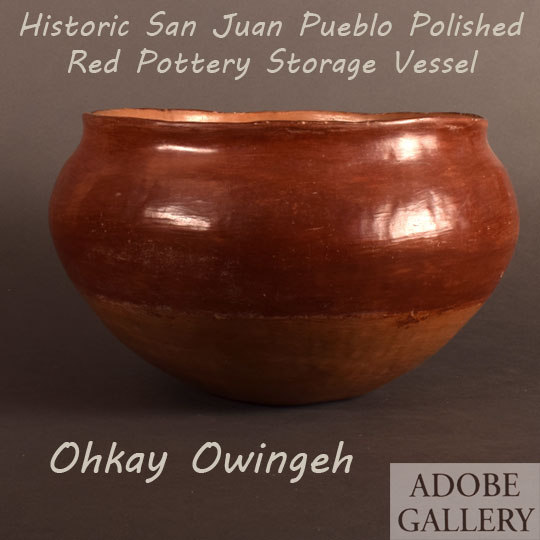
Item #26061 Historic Ohkay Owingeh, San Juan Pueblo Polished Red Pottery Storage Vessel
Unknown Native Artist
clay
8 x 13 inches (L x W)
This pottery vessel might be called a dough bowl or a storage jar, depending on its use. It is typical of traditional San Juan Pueblo (now known as Ohkay Owingeh) Red-on-tan typology and dates from c1900. The upper half of the vessel is covered in deep, highly stone-polished red slip over the basic tan vessel and the lower part remains a stone-polished natural clay body.
The interior was first stone polished to the natural tan clay body and then red clay was painted in a circle in the bottom with four red lines radiating from that center, as if rays of the sun. They climb up the inner wall. I have no explanation for such a design. I’m confident there is a meaning or a purpose but am unable to explain it.
The vessel was fired outdoors and shows several natural "fire clouds," all restricted to the underbody tan color. Fire clouds are not an accident but are deliberate and add immeasurably to the beauty of plainware pottery. They are highly desirable. The walls flare outward and upward, then curve inward before rolling out just slightly at the neck. This is one of the nicest San Juan jars we have had in the gallery. It has a beautiful globular shape with the widest diameter just above mid-point and a short graceful outwardly curving neck. The deep red is a color of earlier San Juan usage, which later turned more orange in tone.
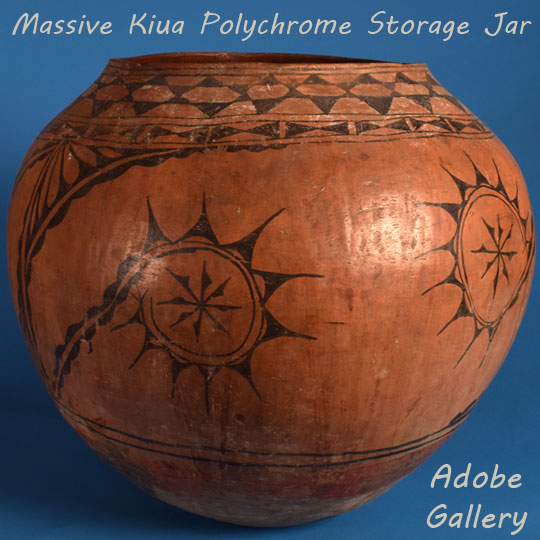
Item #26063 Massive Kiua Polychrome, Cochiti Variety Historic Pottery Storage Jar
Unknown Native Artist
clay, pigments
22 x 22 inches (L x W)
Kiua pottery is produced at Cochiti and Santo Domingo, two Keres pueblos. This very large storage jar, which dates to the mid 1800s and was made at Cochiti, is one of the finest examples of this type of pottery that Adobe Gallery has ever handled. It is very globular in shape and has a rounded bottom, which is typical of mid-century storage jars. The designs are typical of those from the period—simple, uncluttered and elegant. The rag-wiped red band on the underbody was used commonly from the beginning of the historic era to the late nineteenth century.
The jar's designs are absolutely gorgeous. The primary design elements are pairs of curving lines that reach up and down towards the jar's widest point. They begin with shallow curves, and then grow sharper, eventually spiraling into themselves. Triangular and ovular designs repeat along the exteriors of these partial spirals. Within the framing lines' corners, curving along with these graceful spirals, are sloping triangular shapes. Within these sloping triangles, reaching out from the corner, are teardrop-shaped desings. Francis Harlow's Matte-Paint Pottery calls these designs "radiating negative leaves."
A storage jar of this age and size is extremely rare. The ones that do exist are mostly safely stored in museum collections.
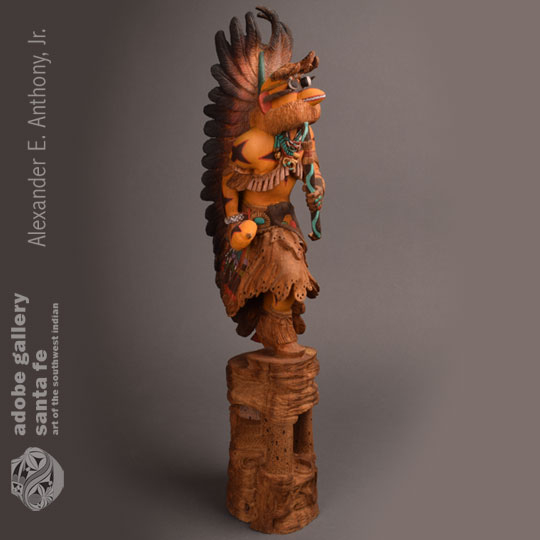
Item #26133 Hopi Pueblo Sikyahote - Yellow A’hote Katsina Doll
Kevin Pochoema (1965- )
wood, stains, acrylic paint
22 x 5 x 5 inches (L x W x D)
Hopi Pueblo artist Kevin Pochoema’s Yellow A’hote Katsina doll is truly spectacular. A’hote’s most immediately striking characteristic is his size. At nearly 22 inches in height—the largest Pochoema katsina doll that Adobe Gallery has ever seen. Remarkably, a single intricately carved piece of cottonwood comprises the majority of the piece. To this main piece of wood, just a few details were attached: A’hote’s bow, rattle, eyes, and three feathers. Most of A’hote’s details—which are many, and which are of particularly high quality—protrude from the main piece of wood. That means that they must be planned and executed with incredible care, as mistakes cannot be easily corrected. Pochoema’s work here is, incredibly, just as intricate as the work we see on his smaller-scale pieces. The four feathers that extend outward from the top of A’hote’s head are most impressive when the viewer is aware that they were not attached to the piece.
The doll is depicted mid-stride, carrying a bow in his left hand and a rattle in his right. His kilt and its various colorful adornments drape elegantly over his knee, as he makes a step upward. One cannot help but notice that A’hote’s colors are absolutely gorgeous. The yellow used for his chest, mask, and rattle is particularly strong. Star designs made of black and red decorate A’hote’s shoulders, arms, chest and face, complementing the rich yellow perfectly. Turquoise and gold, used primarily for A’hote’s jewelry, add a dose of bright color to the piece. A’hote’s elaborate feathered headdress merits praise, too. Each and every one of the dozens of feathers includes a series of small lines extending outward from a single line down its center. Their coloring, too, is impressive, with each feather undergoing a dramatic shift from light to dark as it extends away from the headdress’ center. Pochoema’s process for creating these feathers is quite laborious, but the results are astounding. When discussing a significantly smaller previous creation, he noted that the feathers’ lines and coloring took days to complete.
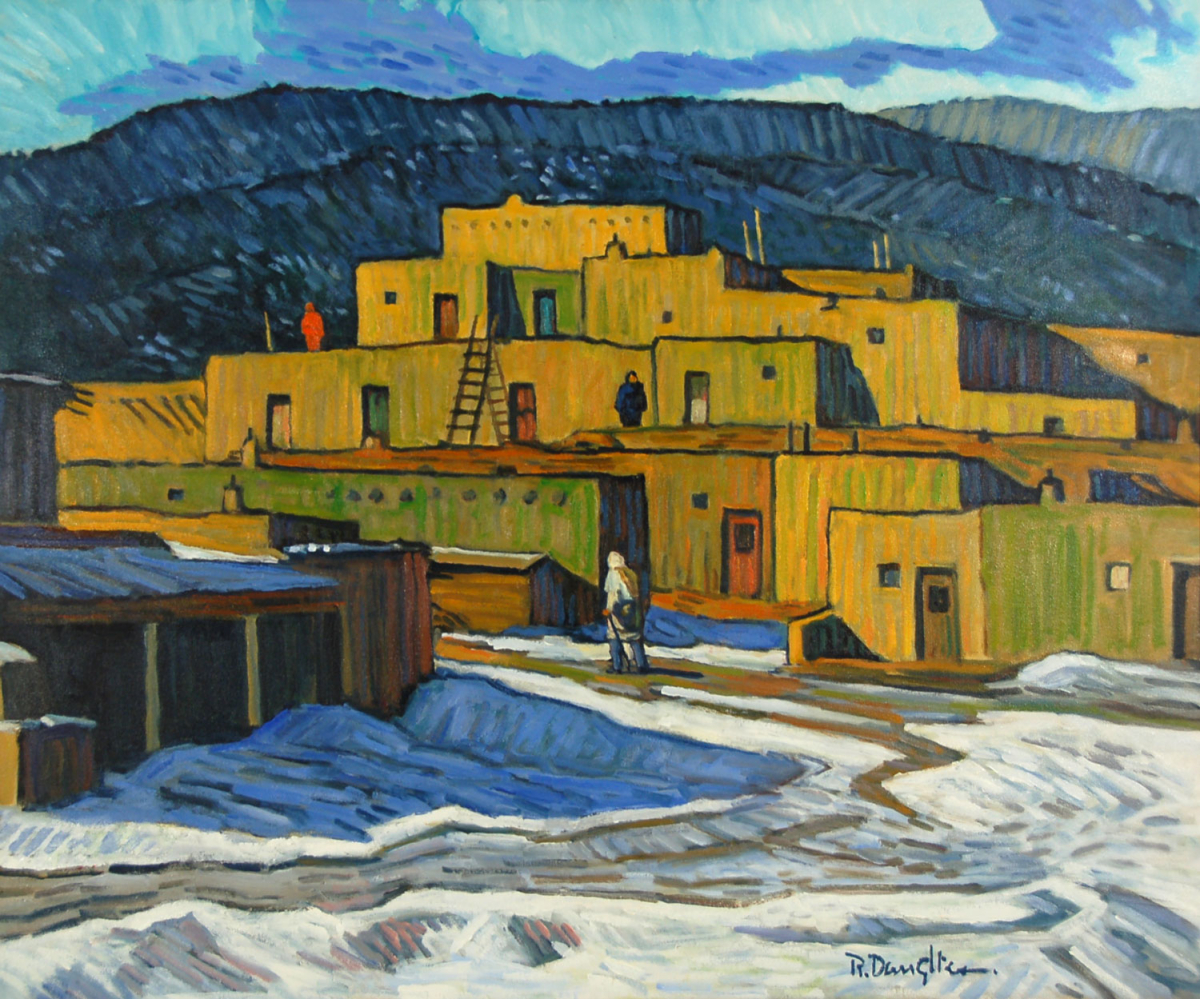
Item #C3738 Original Oil Painting Taos “Pueblo View – Winter”
Robert Daughters (1929-2013)
oil on canvas
25 x 30 inches (L x W)
Robert Daughters specialized in painting landscapes and people of Northern New Mexico, Arizona and Mexico. At the time, he lived in Taos, New Mexico, in a house built by Oscar E. Berninghaus. Daughters was a co-founder of the group of artists known as the Taos Six. The others with him in this group were Walt Gonske, Rod Gobels, Ron Bursano, Ray Vinalla and Julian Robles. This painting is obviously meant to reflect Taos Pueblo but represented in Daughters’ style, a view as interpreted by him when studying the scene. He interpreted the shapes of the buildings, the flow of the water in the river, and the colors reflecting off the buildings and snow with incredible skill.
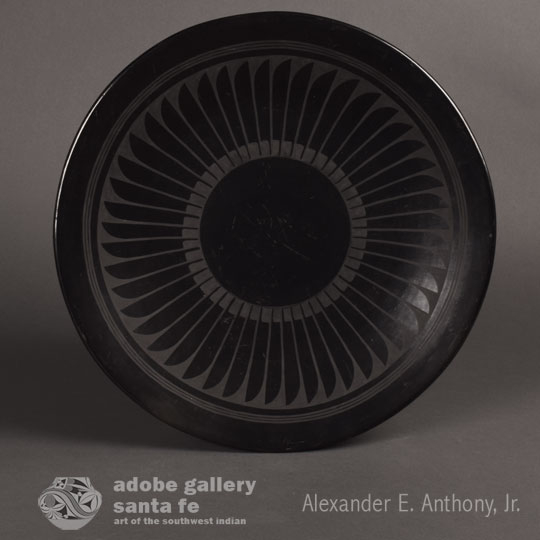
Item #C3813 Large Black-on-black San Ildefonso Pueblo Pottery Plate
Maria Martinez and Santana Roybal Martinez
clay, pigment
14 x 14 x 2 inches (L x W x D)
This is an enormous San Ildefonso Pueblo pottery plate by Maria Martinez, measuring over 14 inches in diameter. There are 48 feathers and three encircling lines near the rim. Each circle was painted freehand using a yucca leaf paint brush. The same process was used for outlining the feathers. It takes a steady hand to paint in that fashion and Santana was very good at doing so.
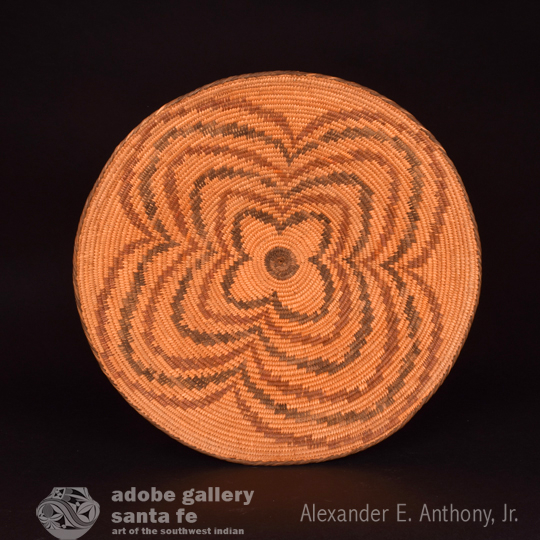
Item #C4082B Akimel O'odham, Pima Polychrome Basket
Unknown Native Artist
cat tail stems, devil’s claw, willow, mountain mahogany
Pima basketry design has always mostly been started with a large black circle in the center from which the design expanded. When the center black circle is minimized, as in this basket, the design is more creative and lighter in structure. The design on this basket has the appearance of exploding outward from the bottom four-petal element as ripples of a wave.
Basketry by the Pima Indian women was practiced in every home in 1900, but by 1920, not one woman in ten knew how to weave a credible basket. By 1935, it was reported that Pima basketry was dying out. Tanner 1983:155
The stitching on this basket is consistently relatively tight, a measure of the talent of the weaver. It is difficult to place a date on this bowl as it does not exhibit use or significant wear patterns. It was quite likely made in the mid-1930s.
The use of red in a Pima basket is quite rare. Generally, Pima basket makers used only devil's claw for the color in their works. This basket has a significant amount of red. Perhaps the artist was influenced by seeing Apache polychrome baskets and chose to try it on her basket. The result is quite successful leading to an image of perhaps a butterfly or a flower.
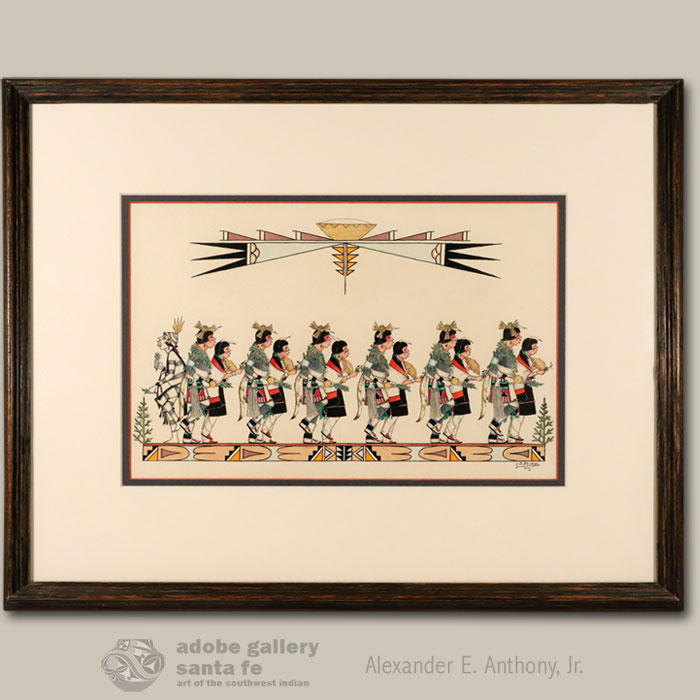
Item #C4139C Original Painting of a San Ildefonso Pueblo Basket Dance Procession
José Disiderio “J. D.” Roybal (1922-1978) Oquwa - Rain God
watercolor
10 x 14 inches (L x W)
This untitled painting features 12 dancers and one Koosa clown by San Ildefonso Pueblo artist J.D. Roybal. Each of the 13 people is depicted in striking detail. A close inspection of the piece reveals a multitude of features that are rarely included in pueblo paintings of this era: careful shading, slight variations in color, and incredibly intricate linework. The male dancers’ evergreen boughs and the female dancers’ baskets are excellent examples of the artist’s considerable technical abilities. While he is most often praised for his representational work, Roybal was also immensely talented when working with more abstract forms. Here, he frames his pueblo dance within colorful abstract designs, adding a personal touch to the image. The end result is an exemplary work from one of the most uniquely talented San Ildefonso painters.
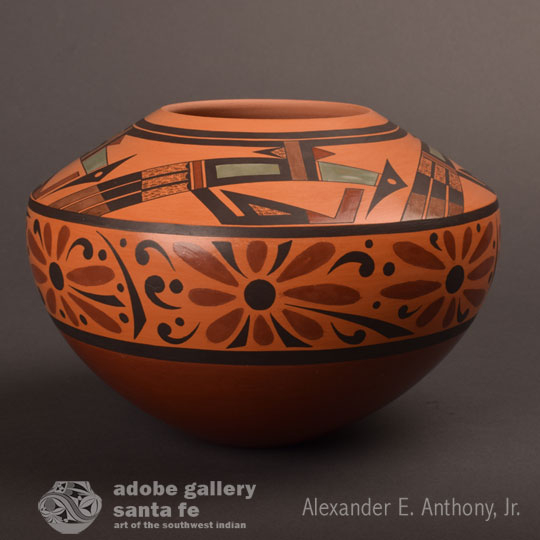
Item #C4231E Polychrome Pottery Jar with Flower Designs
Steve Lucas (1955-)
clay, pigments
6 x 8 inches (L x W)
This polychrome pottery jar will be immediately recognizable to anyone who is familiar with the works of award-winning Hopi-Tewa artist Steve Lucas. Lucas comes from a long line of influential potters; he is continuing his family’s legacy of innovation with his outstanding pottery. As is to be expected, the influence of the artist’s ancestors—Nampeyo of Hano, most notably—is present in the design work on the jar’s upper half. Within and below these more traditional designs, Lucas added his own very personal and unique touches. The top half includes distinctive colors that are not often used on Hopi pottery: a subtle, beautiful grayish purple, as well as a soft blue-green. These colors are used sparingly, blended in among the more traditional colors and designs. When viewed from the top, the viewer sees four arrows. They emerge from the jar’s widest point and curve in towards the center, intersecting with pairs of lines which emerge from the rim’s framing lines. Each arrow ends at the base of the next arrow. This is first-rate design work; it’s clean, creative, and rhythmic.
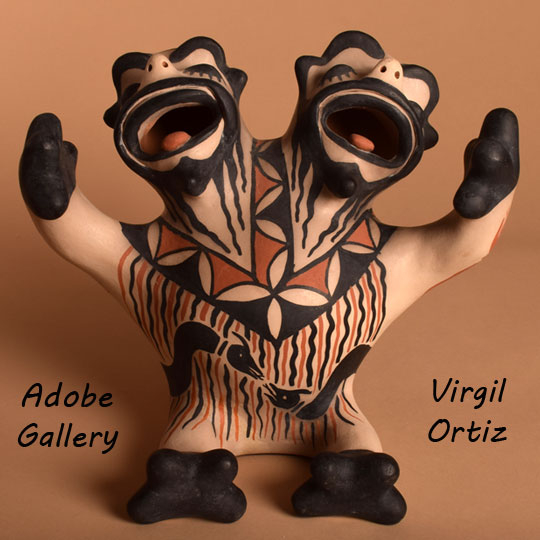
Item #C4268B Cochiti Pueblo Two Headed Seated Male Pottery Figurine
Virgil Ortiz (b.1969-)
clay, pigments
12 x 13 inches (L x W)
This double-headed pottery figure is Virgil Ortiz’s trip back to his ancestral potters who, in the 1880s, made figurines like this that represented sights one might see at a circus. Both heads are the same and their mouths are open with tongues hanging out, as if wailing or in pain. The single body, with two arms and two legs, that supports the two heads is painted in typical Cochiti Pueblo storyteller style with the exception that there are two Avanyu water serpent heads on the torso (see image above), but they are connected to the same body that wraps around the back of the figure—one body, two heads. They appear to be communicating.
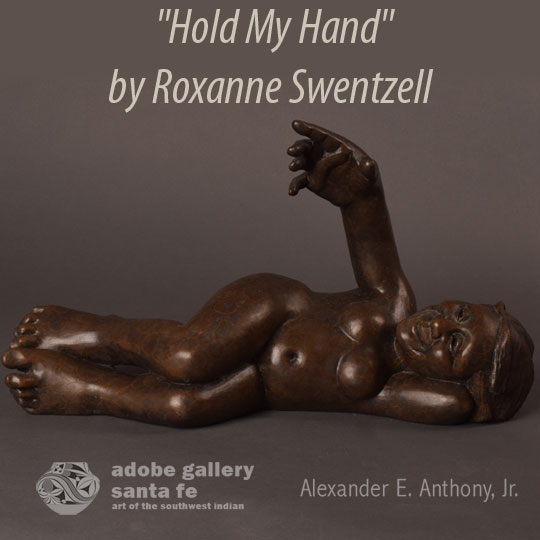
Item #C4295 Santa Clara Pueblo Bronze Sculpture "Hold My Hand"
Roxanne Swentzell (1962 - )
bronze
10 x 18 x 6 inches (L x W x D)
This bronze sculpture by Santa Clara Pueblo artist Roxanne Swentzell titled “Hold My Hand” was cast in an edition 20 and this is number 20. It was originally produced in June or July of 2001 by Roxanne’s sister Poem through Bright Foundry, Inc., Louisville, Kentucky.
The reclining figure appears to be a young woman in a playful mood. She is without clothing as if she just emerged from a bath. She flashes a charming smile. Who could refuse her request? The bronze surface is covered in a texture of circles in a lighter color that breaks the monotony of flat solid bronze color. The circles reflect light and add an interesting patina.
With a family full of potters and sculptors, it was a natural progression for Santa Clara Pueblo Roxanne Swentzell to become an artist. While still in high school, this Native American contemporary legend had the opportunity to study at the Institute of American Indian Arts in Santa Fe. She later found her way to the Portland Museum Art School in Oregon.
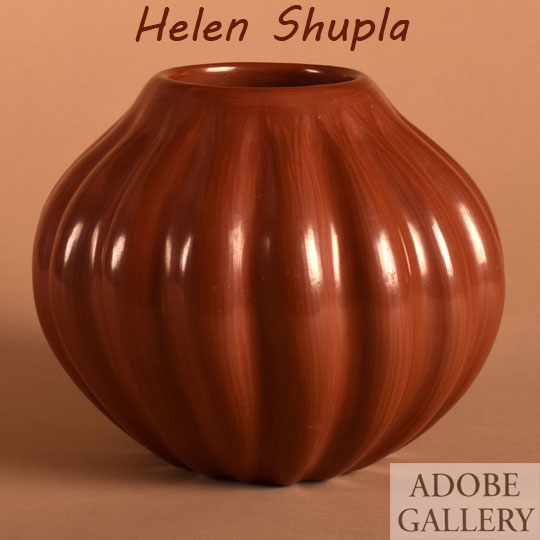
Item #C4349C Santa Clara Pueblo Ribbed Redware Pottery Jar
Helen Shupla (1928-1985)
clay
6 x 7 inches (L x W)
This ribbed redware pottery jar was created by Santa Clara Pueblo artist Helen Shupla. Shupla was known for mastering the melon jar form seen here. Looking at the inside of the jar reveals that she made the ribs by pushing outward from the inside. Shupla pioneered this technique while others were still carving clay off of vessels to form ribs.
This jar is a fine example of Shupla’s innovative contribution to the world of Santa Clara Pueblo pottery. Its shape—round, with a flat bottom and an upturned rim—is graceful and elegant. Its rich red color is fantastic. A visiting client who collects historic pottery asked if this piece came from San Juan Pueblo, and his question made sense—the jar’s color is nearly identical to that of the handful of historic San Juan redware pots displayed on our shelves. Many contemporary Santa Clara pieces are a bit brighter than this piece’s gorgeously subdued red tone. As per Shupla’s usual, each rib is identical in shape and size. They bend outward, reaching their widest points at the vessel’s midbody. This beautiful pot deserves the attention of collectors who appreciate excellent contemporary Native pottery.
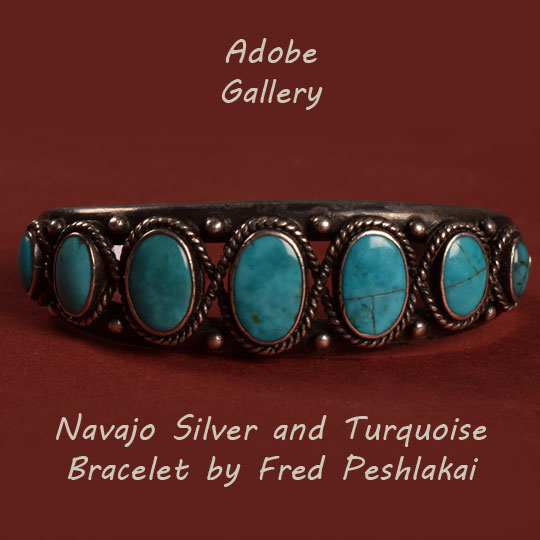
Item #C4361A Navajo Silver and Turquoise Bracelet
Fred Peshlakai (1896-1974)
silver, turquoise
This silver bracelet with seven turquoise gemstones was made by Fred Peshlakai, Diné jeweler of the Navajo Nation. The turquoise cabs are oval and domed and graduated in size from the largest in the center to the smallest at the ends. Each turquoise cab is secured in a silver bezel. The seven bezels are intertwined in a continuous twisted silver rope. The bracelet is stamped with his name, in all caps, F.PESHLAKAI.
The foundation of the bracelet is two silver bars melding into solid silver near the ends of the bracelet. The solid sections are filled with traditional stamped designs. The row of turquoise cabs is secured to the silver foundations by a silver platform that has a silver rivet as the anchor, however, it appears that the twisted silver wire is what is anchored to the foundation.
All seven turquoise cabs are of the same lustrous color and obviously from the same turquoise mine. It is a beautiful high-quality turquoise but I do not know the mine source. Two of the turquoise cabs have a crack across the middle, but each is securely anchored in the bezel.
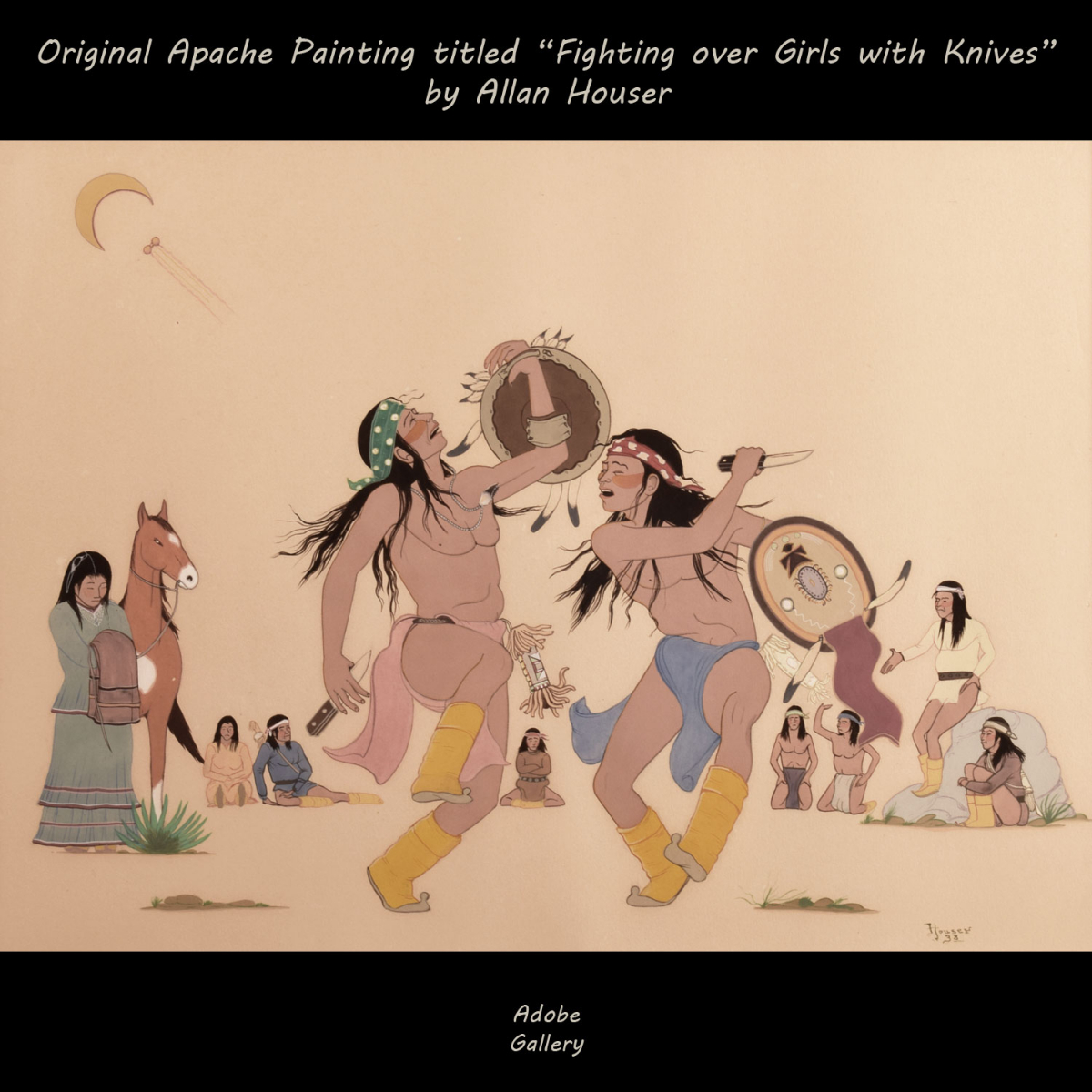
Item #C4372B “Fighting over Girls with Knives”
Allan Houser (1914-1994) Haozous
watercolor
12 x 16 inches (L x W)
“Fighting over Girls with Knives” is dated 1938, which identifies it as having been completed at the tail end of Houser’s Indian School period. One might infer as much without reading the date, as the image looks like Houser’s own highly evolved version of the flat style. Houser’s primary subjects here are two Apache men. The painting’s wonderful title tells us that they are fighting, but their fight appears to be every bit as graceful and beautiful as a ceremonial dance. Perhaps this is not a violent fight, but some sort of display of affection for the female onlookers. Whatever the case may be, Houser’s work is fantastic.
The muscular young men hold knives and shields, and wear nothing more than moccasins, headbands, and loin cloths. The man on the right appears as though he is about to strike. The man on the left, interestingly, holds his knife by its blade. His pose is particularly dance-like, suggesting to the viewer that the men might be putting on a show for the gathering spectators. Both men move with their eyes closed, as if fully absorbed in the proceedings. Houser handled the action with incredible skill, outlining his men with impeccable thin lines. Each of the nine spectators—eight humans and one particularly attentive horse—was crafted with the same sensitivity and care as the men in the foreground. Certain spectators make expressive gestures with their hands; others appear to be bored. A prominently featured young woman hangs her head, as if she has had enough of this testosterone-fueled display. “Fighting over Girls with Knives” is a rare and wonderful painting from one of the most significant artists of the twentieth century.
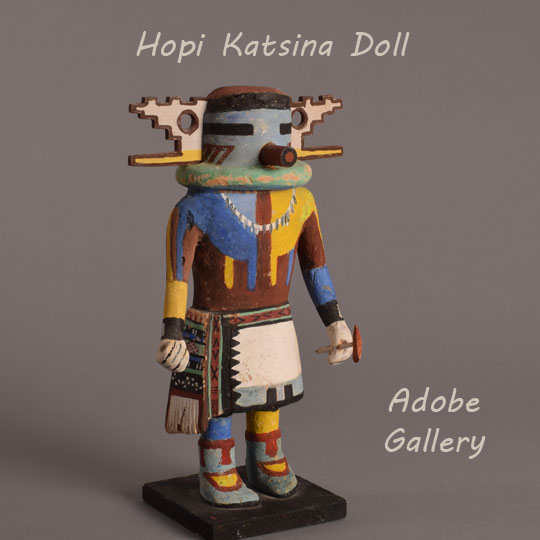
Item #C4384.21 Unidentified Hopi Katsina Doll from the Fred Harvey Advertising Department Collection
Unknown Native Artist
wood, paint
10 x 6 inches (L x W)
This Pueblo katsina doll has all the attributes of a traditional Hopi carving. It was carved from cottonwood root, appears to have been carved with a knife, and was painted with traditional matte-finish paints. On the back of the head, a string was inserted into the head from which to secure feathers. This is an old traditional Hopi trait. He has the blue face, red slants on his cheeks, red top of the head, and horizontal black eyes of the A-ha Katsina, who is one of the Chief Katsinas of Second Mesa.
He has the body paint, green ruff, and tubular mouth of a Ma’alo and other Katsinas. It is then that the identity of the specific katsina is concealed with the addition of the elaborate ears. There is no Hopi katsina with that style of ears. It was surely an attempt by the maker to make him look more appealing when exhibited by the Advertising Department, or, possibly a deliberate attempt by the carver to not make an accurate doll that was going to have non-Hopi purposes such as in advertising. To an uninformed novice collector or tourist, it has all the appeal of an authentic Hopi katsina.
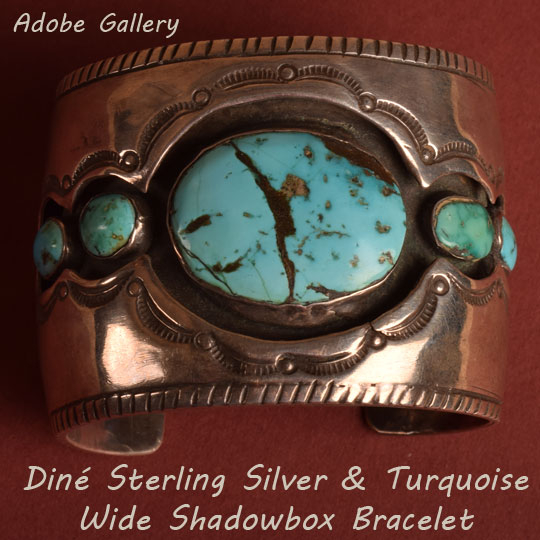
Item #C4386A Diné Sterling Silver and Turquoise Wide Shadowbox Bracelet
Unknown Native Artist
silver, turquoise
This Navajo turquoise bracelet was constructed from two separate sheets of wide silver. The lower sheet was treated to a black finish. The top sheet was separated from the lower one by ⅛ inch to achieve a shadow box arrangement. A large and beautiful blue turquoise cabochon with a copper color matrix was placed in a silver bezel as the central eye-catching feature. On each side of this central gemstone are two smaller turquoise cabochons positioned in a similar manner.
Simple stamping encircles the placement of the turquoise, significant enough for effect but not to detract from the magnificence of the turquoise arrangement. The impressive width of the bracelet and the beauty of the blue turquoise floating on a black background resulted in an impressive cuff. It was not signed by the artisan and most likely dates to the 1960s when shadow-box arrangement was popular.
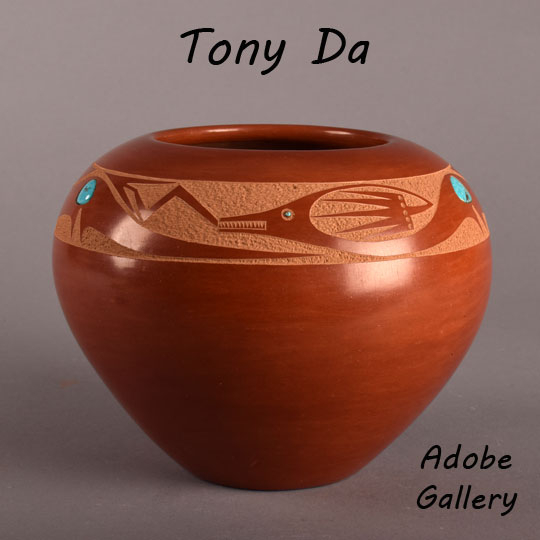
Item #C4410 Sgraffito Redware Pottery Jar with Turquoise
Tony Da (1940-2008) Thun-Phoe-She
clay, pigments, turquoise
5 x 6 inches (L x W)
This exceptional redware pottery jar was created by San Ildefonso Pueblo artist Tony Da. As a descendent of Maria Martinez, Da was born into a family of influential artists. He went on to become one of the most significant members of an incredibly talented family. Today, his works rank among the most valuable and sought-after Native American artworks. The strong market for Da’s works can be attributed to their beauty, of course, but also to their relative scarcity. Da’s potting career was short, and he is known to have completed only 30 pots a year. It is always exciting to have the opportunity to handle one of these rare and wonderful pots.
This sgraffito-etched redware jar, which dates to the late 1960s or early 1970s, is an excellent example of Tony Da’s work. Its primary design element is a band circling the jar just above its widest point. This design band uses precise sgraffito etching to create an Avanyu figure. The Avanyu—etched in reverse, essentially, as its body is made of the jar’s polished surface—is a technical marvel. Every detail, down to its row of tiny teeth, is as close to perfect as one could hope for in an artwork that is made by hand. The Avanyu curves gracefully around the jar, standing on four pairs of legs. Above each pair of legs is an inset turquoise gemstone. The areas between the legs feature wide rain cloud designs. A round miniature piece of turquoise serves as the Avanyu’s eye. The eye and the four larger pieces of turquoise are spaced evenly around the jar. The etching reveals the jar’s buff clay body, which is stippled, creating a different texture to complement the polished exterior’s smooth sheen.
The jar’s color is a rich, gorgeous red, and its exterior is polished to perfection. Its shape is excellent. The base, at just 2-½” in diameter, is narrow, which means that the sides must flare outward widely to reach the 6-½” diameter of the jar’s widest point. Above this point is the design band, then the polished rim. There is no neck, no lid, and no elaborate design work here, and none of that is needed. This is a classic pueblo pot that bears its gifted creator’s distinctive stylistic choices without veering too far from tradition. We are pleased to offer another pueblo pottery masterpiece from the great Tony Da.
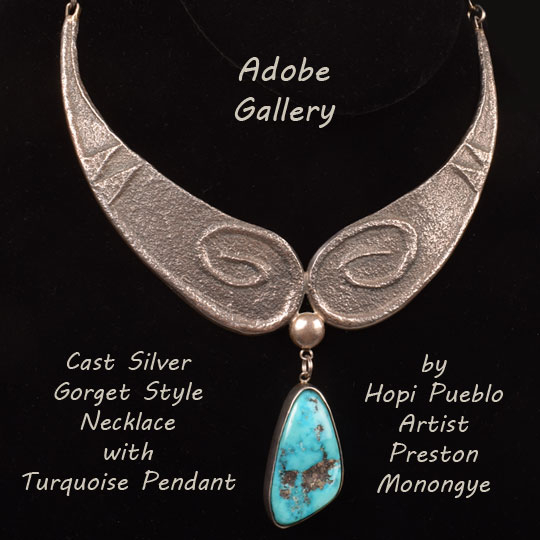
Item #C4413A Hopi Pueblo Cast Silver Gorget Style Necklace with Turquoise Pendant
Preston Monongye
silver, turquoise
This silver casting by Hopi Pueblo artist Preston Monongye has the appearance of having been cast in sand. The surface texture is a sandy finish. The two tear-shape castings are attached at the bottom, making for a fixed, not flexible section. A silver drop, placed at the base, is the anchor for the large beautiful blue turquoise gemstone. The silver chain was handmade. The silver backing of the turquoise bears the logo of the artist.
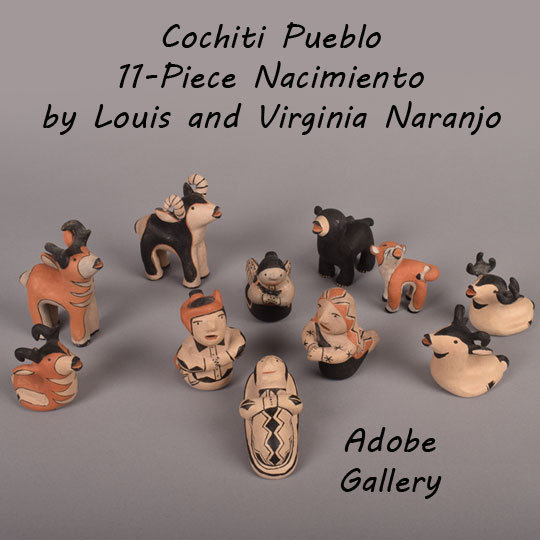
Item #C4414A Cochiti Pueblo 11-Piece Pottery Nacimiento or Nativity Scene
Louis Naranjo (1932-1997) and Virginia Naranjo (b.1932)
clay, pigment
This eleven-piece Pueblo Pottery Nacimiento by Louis and Virginia Naranjo consists of Mary, Joseph and Infant Jesus, and an angel. The angel has holes in her wings so that she can be suspended over the other figures, if desired.
In the animal kingdom, there are a black bear, a male bighorn sheep, an antelope, and a fox—all of which are standing—and a deer, an antelope, and a female bighorn sheep—all of which are resting.
Louis Naranjo and his wife Virginia are included in the Monthan’s book "Nacimientos: Nativity Scenes by Southwest Indian Artisans" which was published in 1979. They state that Louis started making Nacimientos around 1970 so he was part of the movement that occurred at that time. Nacimientos, in fact figures of all kinds, by Louis are among the most collected by those who like figurative pottery. His pottery is much appreciated because he was technically good at the craft and he had a wonderful sense of humor which he incorporated into his work.
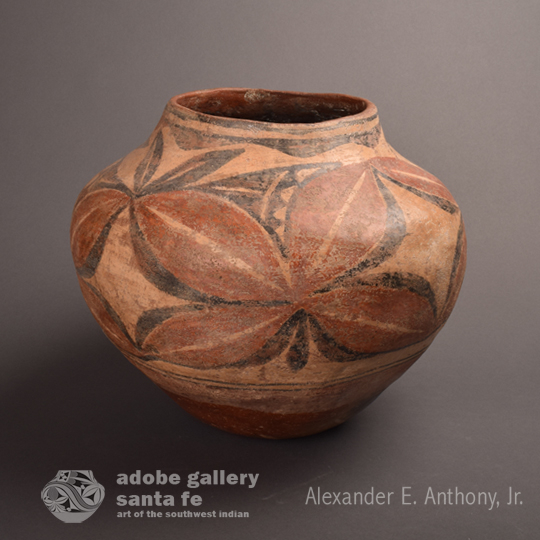
Item #MM146 Nineteenth Century Well-used Zia Pueblo Polychrome Pottery OLLA
Unknown Native Artist
clay, pigments
10 x 12 inches (L x W)
For those collectors who relish collecting pottery that exhibits prior use at a pueblo home, this historic Zia Pueblo pottery jar is a true treasure. It is a mid-1800s example of Zia pottery at its most creative period before potters settled into using the Zia bird as a standard design element. Earlier jars, such as this one, clearly display the desire of the potter to create something of beauty for her own pleasure and the pleasure of her family to enjoy on a daily basis as it sat on display and in use in the kitchen. This jar has a beautiful large floral element not seen on vessels after the turn of the century. Pottery of the nineteenth century displayed a variety of designs, most of which were not used after the turn of the century, a loss attributed to potters giving in to the commercial market.
This extraordinary well-used olla from Zia Pueblo, created between 1840 and 1860 was coil-formed in native clay with the addition of crushed basaltic temper. The underbody was stone-polished bare paste in a warm brick red color. A wide red band was wiped on as a dividing line between the bare paste underbody and the decorated upper body.
The design field was slipped in a creamy white slip on which was painted four very large floral elements prominently displayed in Georgia O’Keeffe style.
The jar was used extensively as a water container for many years as evidence by the white ring of calcium deposit on the interior and some leaching of the calcium to the exterior. It is in excellent structural condition.
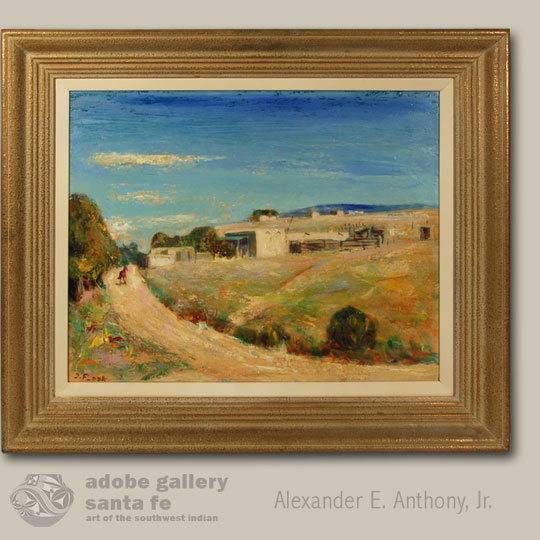
Item Item # 25802 Untitled Scene of Hacienda with Horse on Road
Joseph Amadeus Fleck
oil
16 x 20 inches (L x W)
This Southwestern landscape by artist Joseph Fleck is a fine example of why his works have been sought after by collectors. There is no focal point here—it is a subtle, well-balanced image that doesn’t rely on movement or bursts of bright color to draw and keep the viewer’s attention. The scene depicted here is a simple and peaceful one: a single horse on a dirt road, winding past a quiet Southwestern hacienda. Fleck paid particular attention to the trees and hills surrounding the ranch, blending his colors together beautifully to give the scene an incredible amount of depth and dimension. Behind the hacienda, a small cluster of houses occupies a hilltop. Beyond that, all the viewer sees is blue. Fleck’s gorgeous blue sky evolves as it extends away from the hillside, from a simple light blue to a richer, darker blue. The image is easily accessible and could be appreciated by anyone who gives it a cursory glance. However, a more focused study will reveal a surprisingly complex and elegant composition that rewards repeated viewings.
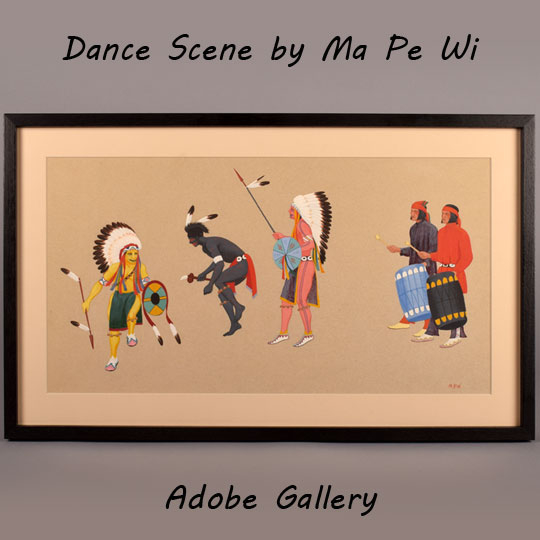
Item Item # C4420 Untitled Five-Figure Ceremonial Dance Scene
Velino Shije Herrera (1902-1973) Ma Pe Wi
watercolor
10 x 19 inches (L x W)
This untitled dance scene is another excellent offering from Herrera. It features five dance participants, with no background or ground plane. On the right, we see two drummers in traditional pueblo attire. On the left, directly in the drummers’ path, we see three dancers. They wear the attire and carry the weaponry of Plains Indian tribes—colorful shields, massive spears and elaborate feathered headdresses. Two dancers are depicted in profile; the third turns directly toward the viewer, allowing a good look at the intricacies of his clothing. As per usual, Herrera’s work is exceptionally detailed, with fine linework, careful shading and a vibrant color palette. The feeling of depth and dimension that this image conveys is what sets Herrera apart from many of his peers. This is a beautiful piece from a skilled Pueblo traditionalist.
Sold
